Publications
Publications listed in reversed chronological order.
Select a category:
journal articles
2025
-
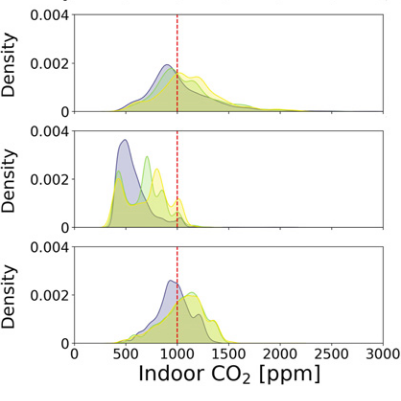 The Influence of Occupant Behaviour on Indoor Air Quality and COVID-19 Risk in Refugee Shelters and Temporary HousesAnna Conzatti, Daniel Fosas, Tristan Kershaw, and 3 more authorsBuilding Services Engineering Research & Technology, 2025
The Influence of Occupant Behaviour on Indoor Air Quality and COVID-19 Risk in Refugee Shelters and Temporary HousesAnna Conzatti, Daniel Fosas, Tristan Kershaw, and 3 more authorsBuilding Services Engineering Research & Technology, 2025There are growing concerns about poor indoor air quality in refugee shelters, particularly regarding chronic health conditions and the spread of airborne diseases like COVID-19. These issues are influenced by shelter design and occupants’ behaviours, such as cooking and window usage. However, behavioural aspects are often overlooked in shelter design due to the challenges of monitoring occupants, which can be costly and intrusive. To address this, we developed a cost-effective method for assessing shelters that combines self-assessed behavioural data, predicted ventilation rates, and a mathematical model for airborne disease transmission. This approach was tested in temporary housing following the 2020 floods in Kumamoto Prefecture, Japan. Results indicated that indoor CO2 levels exceeded national thresholds over 70% of the time, suggesting inadequate ventilation to mitigate airborne disease transmission. We estimated a 60–80% risk of COVID-19 transmission under these conditions. Our findings highlight severe health inequalities in forcibly displaced populations and provide: (i) the first comprehensive guide to monitoring indoor conditions and behaviours in these settings; (ii) a new model for assessing airborne disease risk. While the study focuses on COVID-19, the results can be extended to other airborne respiratory diseases through our reproductive number (R0) estimates.
@article{conzatti2025influence_ob, title = {The Influence of Occupant Behaviour on Indoor Air Quality and {{COVID-19}} Risk in Refugee Shelters and Temporary Houses}, author = {Conzatti, Anna and Fosas, Daniel and Kershaw, Tristan and Nakaya, Takashi and Coley, David and Rijal, Hom Bahadur}, year = {2025}, journal = {Building Services Engineering Research & Technology}, doi = {10.1177/01436244251340358}, url = {https://journals.sagepub.com/doi/10.1177/01436244251340358}, } -
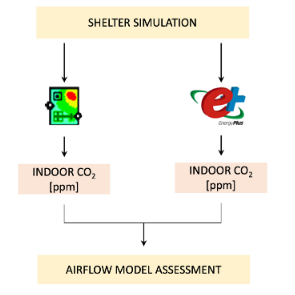 Are simple models for natural ventilation suitable for shelter design?Anna Conzatti, Daniel Fosas, Ben Chater, and 1 more authorBuildings & Cities, 2025
Are simple models for natural ventilation suitable for shelter design?Anna Conzatti, Daniel Fosas, Ben Chater, and 1 more authorBuildings & Cities, 2025Many competing airflow models are available to aid designers size windows for natural ventilation, but their complexity in terms of computation and the required expertise needed has limited their application in shelter design. Shelters house over 8 million people worldwide, and the prevalent inadequacy of indoor air quality exacerbates health risks. This study examines the use of simplified airflow models to guide the shelter design process to deliver adequate natural ventilation schemes and window dimensions. The classic Warren equations for natural ventilation are compared with airflow network models in Contam and EnergyPlus to contrast design outcomes from a practical perspective. Five natural ventilation mechanisms are tested across a representative single-zone shelter, based on those at Hitsats refugee camp (northern Ethiopia), using indoor CO2 concentrations as the key performance indicator. Results for opening sizes and ventilation layouts derived from Warren are in close agreement with those from airflow network models in Contam and EnergyPlus. Wind-driven scenarios feature the same window size for 99% of the time, while buoyancy-driven scenarios are for 94–97% of the time. These results prove that simplified modelling approaches would lead to the same design decisions as more complex models, making them as suitable and as reliable for the design of single-zone shelters.
@article{conzatti2025nv_simple, title = {Are simple models for natural ventilation suitable for shelter design?}, author = {Conzatti, Anna and Fosas, Daniel and Chater, Ben and Coley, David}, year = {2025}, journal = {Buildings \& Cities}, volume = {6}, pages = {158--181}, issn = {26326655}, doi = {10.5334/bc.497}, url = {https://journal-buildingscities.org/articles/10.5334/bc.497}, } -
 Decarbonising non-domestic buildings at scale - A systematic reviewDaniel Fosas, Ozgur Gocer, Arianna Brambilla, and 3 more authorsEnergy and Buildings, 2025
Decarbonising non-domestic buildings at scale - A systematic reviewDaniel Fosas, Ozgur Gocer, Arianna Brambilla, and 3 more authorsEnergy and Buildings, 2025The imperative for decarbonization demands the swift realization of net-zero buildings by 2050. Significant efforts have been directed at new buildings but, looking ahead, there is a need to shift towards whole-life management given buildings’ extensive lifetimes. With this objective in mind, this paper delves into scalable strategies for decarbonizing building stocks by conducting a systematic literature review concentrated on the in-use life cycle stage of buildings. Its scope is non-domestic building portfolios, a complex, under-researched stock that features dedicated teams overseeing their maintenance and operation - a management approach ideally placed to address sustainability challenges. Recent literature is analysed according to assessment of building portfolios, intervention types, and rollout mechanisms. This is then complemented with non-academic literature and governmental initiatives worldwide. Findings highlight challenges in understanding the performance of buildings in sufficient detail to inform effective retrofit planning and financing interventions. Fabric-first approaches, while desirable for their multiple benefits beyond reduced environmental impacts, do not necessarily arise as the most economically competitive measures. In contrast, just understanding and optimising energy use is reported to deliver 20% energy savings cost-effectively. Overall, findings highlight challenges and opportunities associated with proactive management of buildings alongside areas for future research.
@article{fosas2025decarbonising, title = {Decarbonising non-domestic buildings at scale - A systematic review}, author = {Fosas, Daniel and Gocer, Ozgur and Brambilla, Arianna and Globa, Anastasia and Yildirim, Muhammed and Friedrich, Daniel}, year = {2025}, journal = {Energy and Buildings}, volume = {}, pages = {}, issn = {}, doi = {10.1016/j.enbuild.2025.115587}, url = {https://www.sciencedirect.com/science/article/pii/S0378778825003172}, }
2023
-
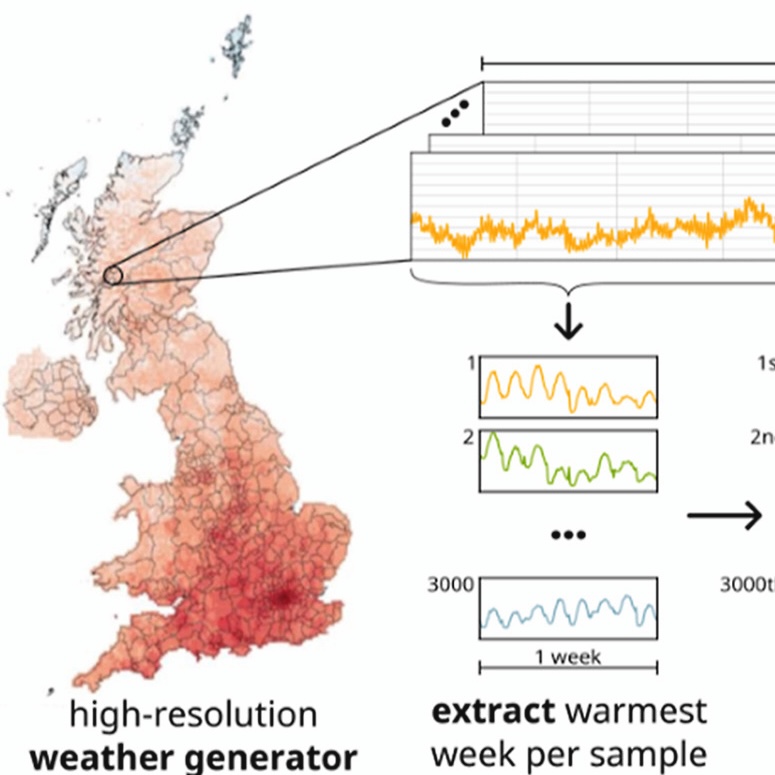 The Week That Will Be: Communicating the Impact of Climate Change via Extreme WeeksDavid A. Coley, Chunde Liu, and Daniel FosasBuilding and Environment, 2023
The Week That Will Be: Communicating the Impact of Climate Change via Extreme WeeksDavid A. Coley, Chunde Liu, and Daniel FosasBuilding and Environment, 2023As events like the 2003 European heatwave showed (where 14,000 people died in Paris alone), it is in the extremes of weather, not the mean climate, where much climate change risk lies. Communication with the public, or the testing of natural and human-made environments via simulation, has focused however on the mean situation. To many, a future 2 or even 4 °C rise in mean temperature will seem modest and hence fail to convey the scale of the issue, thereby creating a gap between reality and expectation. Here we use the idea of presenting an audience with a week-long time series of future local extreme weather as a way of bridging this gap. A week has both vernacular currency and covers the length of many heatwaves. We generate UK future weeks in 2030, 2050 and 2080 at a 5 km interval, thereby allowing interested parties to visualise for the first time likely future heatwaves in their locality. Future heatwaves of similar form as the 2003 Paris event are found, but with even higher temperatures, suggesting the likelihood of largescale mortality. We apply the approach to the conditions within a UK home under future heatwaves with return periods of 10–50 years. Conditions far beyond adaptive comfort limits are found. Weather files containing the extreme weeks for 11,326 locations have been prepared and are made available. These will be of use to those trying to explain the likely impacts of climate change, governments setting resilience policy and those using computer modelling.
@article{coley2023week_that_will_be, title = {The Week That Will Be: Communicating the Impact of Climate Change via Extreme Weeks}, author = {Coley, David A. and Liu, Chunde and Fosas, Daniel}, year = {2023}, journal = {Building and Environment}, volume = {227}, pages = {109809}, issn = {0360-1323}, doi = {10.1016/j.buildenv.2022.109809}, url = {https://www.sciencedirect.com/science/article/pii/S0360132322010393}, }
2022
-
 Towards Active Buildings: Stakeholder Perceptions of the Next Generation of BuildingsElli Nikolaidou, Ian Walker, David Coley, and 3 more authorsEnergies, 2022
Towards Active Buildings: Stakeholder Perceptions of the Next Generation of BuildingsElli Nikolaidou, Ian Walker, David Coley, and 3 more authorsEnergies, 2022Best Paper Award on Energy at CLIMA 2022 The 14th REHVA HVAC World Congress (Rotterdam).
Several regulations and standards have been developed to reduce the carbon footprint of buildings, but these have failed to provide a clear pathway to a net zero future. Hence, we recently introduced the Active Building Code (ABCode). This provides guidance on reducing the environmental impact of the next generation of buildings, termed Active Buildings (ABs), through their synergy with the grid. This paper aims to illuminate the regulatory landscape, justify our initial proposal for the ABCode, and reveal opportunities and challenges to the popularisation of ABs. Twelve online focus group discussions were conducted, with thirty stakeholders in total, all selected on the basis of their expertise. A grounded theory approach identified five core themes in such discussions. These strongly overlap with what is incorporated in the ABCode, suggesting the code successfully captures issues important to experts. Stakeholders defined ABs as responsive buildings and proposed both energy and carbon are considered in their assessment. They hence aligned with the definition and evaluation framework proposed by the ABCode. Finally, stakeholders considered people’s tendency to prioritise capital cost as the greatest challenge to the popularisation of ABs, and the increasing demand for healthy environments as its greatest opportunity.
@article{nikolaidou2022abc_stakeholder, title = {Towards Active Buildings: Stakeholder Perceptions of the Next Generation of Buildings}, author = {Nikolaidou, Elli and Walker, Ian and Coley, David and Allen, Stephen and Fosas, Daniel and Roberts, Matthew}, year = {2022}, journal = {Energies}, volume = {15}, pages = {5706}, publisher = {Multidisciplinary Digital Publishing Institute}, issn = {1996-1073}, doi = {10.3390/en15155706}, url = {https://www.mdpi.com/1996-1073/15/15/5706}, } -
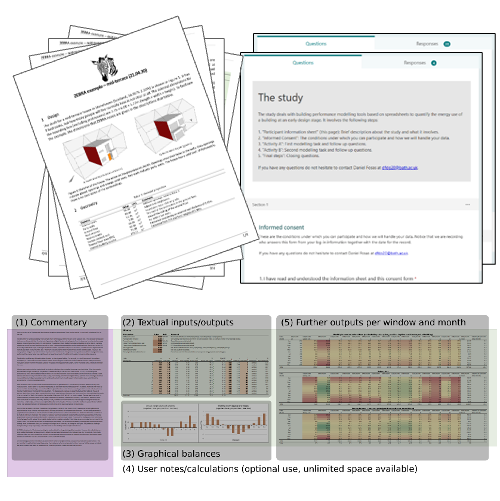 Novel quick-to-use, pedagogical model for scoping low energy and low carbon buildingsDaniel Fosas, Rachel Mitchell, Elli Nikolaidou, and 4 more authorsBuilding and Environment, 2022
Novel quick-to-use, pedagogical model for scoping low energy and low carbon buildingsDaniel Fosas, Rachel Mitchell, Elli Nikolaidou, and 4 more authorsBuilding and Environment, 2022Since early-stage decisions have the largest impact on climate related emissions, if modelling is to help deliver zero carbon designs, tools are needed that can be used by those involved at this stage. By contrast, tools that require a detailed description of the building or a specialist have less usefulness at this point in the design cycle. So, just how simple can models be (mathematically and interface-wise), to give meaningful answers to decisions such as the shape of the building and the glazing ratio? The ideal tool would be pedagogical and leave the user with knowledge that they could apply even earlier to the next project. In this work we present ZEBRA, a highly simplified, quick-to-use, model for scoping zero-carbon buildings. The model only requires approximately 33 inputs, no training, considers embodied emissions and renewables and leaves the user upskilled on zero carbon design. The predictions from 5 very low energy buildings placed into 559 climates obtained by this new model are compared to the leading model for high-performing buildings. The average difference was 0.9 kWh·m⁻²·a⁻¹ (SD=0.6). The mean time taken to model a building by someone not previously exposed to ZEBRA was 35min (SD=8), and 17min (SD=3) on second use. Therefore, ZEBRA is highly accurate when compared to the best-in-class tool and can be used quickly by the uninitiated. Hence ZEBRA has the potential to be highly useful as a first-pass tool whilst simultaneously rapidly upskilling the industry.
@article{fosas2021zebra, title = {Novel quick-to-use, pedagogical model for scoping low energy and low carbon buildings}, journal = {Building and Environment}, volume = {208}, author = {Fosas, Daniel and Mitchell, Rachel and Nikolaidou, Elli and Roberts, Matthew and Allen, Stephen and Walker, Ian and Coley, David A.}, year = {2022}, }
2021
-
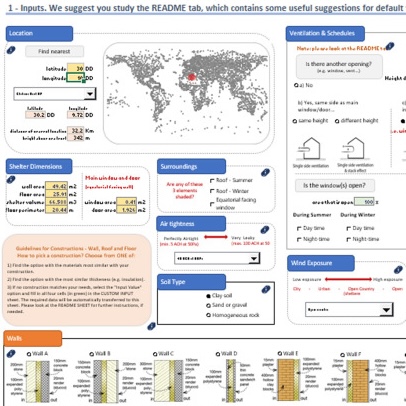 ShelTherm: an aid-centric thermal model for shelter designManuela de Castro, Noorullah Kuchai, Sukumar Natarajan, and 5 more authorsJournal of Building Engineering, 2021
ShelTherm: an aid-centric thermal model for shelter designManuela de Castro, Noorullah Kuchai, Sukumar Natarajan, and 5 more authorsJournal of Building Engineering, 2021The growing displacement crisis leaves many housed in simple shelters, which are bespoke to each setting, often sited in harsh climates and normally unconditioned. Measurements have shown that the thermal environment within the shelters can be life-threatening. Hence aid agencies are interested in improving these conditions. Unfortunately, given the skill set within agencies, there is little possibility to use complex thermal modelling to predict the impact of different materials or constructions. Hence the need to provide simple methods. In this work, we introduce a new physics-based thermal model (ShelTherm) for simple structures and encapsulate it within a tool designed to be used by humanitarian staff. Unlike other reduced models, the method is capable of dealing with high ventilation/infiltration rates, thin materials (such as tarpaulin) and high U-values. The model was validated over a wide variety of architectures, materials and climates. Mean error against observed data from a variety of real shelters was +0.94 °C (s.d. 0.79 °C), comparing favourably against the well-known reduced model CIBSE Admittance method (+4.95 °C, s.d. 0.89 °C) and the industry standard Energy+ (+0.60 °C, s.d. 0.32 °C). ISO 13792:2012(E) classified it as a Class 1 model, the highest possible. The differences between the new method and Energy+ across block, tarpaulin and stone shelters in Ethiopia, Bangladesh and Nepal were always less than 1.3 °C, and +0.24 °C for shelters in a mild climate. Humanitarian workers classed the tool as “easy” or “very easy” to use. The typical time to model a shelter by a first-time user was 34 minutes. ShelTherm can hence be seen as highly fit-for-purpose due to its overall accuracy and ease of use.
@article{manuela2021shelterm, title = {ShelTherm: an aid-centric thermal model for shelter design}, journal = {Journal of Building Engineering}, volume = {44}, author = {{de Castro}, Manuela and Kuchai, Noorullah and Natarajan, Sukumar and Adeyeye, Kemi and Fosas, Daniel and Moran, Francis and Wang, Zu and Coley, David A.}, year = {2021}, } -
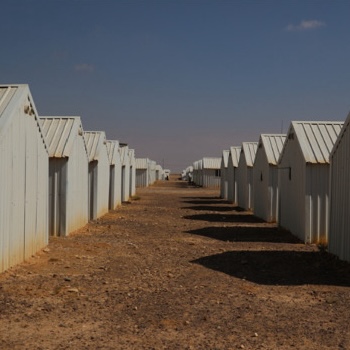 Improving Thermal Comfort in Refugee Shelters in Desert EnvironmentsFrancis Moran, Daniel Fosas, David A. Coley, and 3 more authorsEnergy for Sustainable Development, 2021
Improving Thermal Comfort in Refugee Shelters in Desert EnvironmentsFrancis Moran, Daniel Fosas, David A. Coley, and 3 more authorsEnergy for Sustainable Development, 2021Empirical studies have shown that internal temperatures in refugee shelters are impacting morbidity, and possibly mortality. Within a displacement setting, solutions are often constrained by time, cost, material availability and local requirements. This often results in “deemed suitable” designs rather than optimal solutions. In this study, we ask which route is most appropriate to optimise thermal comfort: prototyping design improvements, which requires time but may not require significant domain expertise, or thermal modelling, which can be quickly carried out if there is expertise. In a unique experiment, a laboratory of 12 shelters, built in a desert refugee camp, was adapted by the refugees themselves with variants to improve thermal comfort. Thermal modelling and field results were compared. Prototyping, though requiring additional time, was found to offer several advantages over modelling: (a) it gives a more visceral answer, in that the agency staff and refugees can experience the improvement - this could be important as most people might not be able to relate to a numeric statement about temperature; (b) the difficulty of constructing variants can be compared; (c) the financial and time costs are identified accurately. This suggests that such prototyping experiments have great utility, conferring substantial advantages over computer-based modelling. Significantly, we show that simple adaptations can improve conditions by up to 6 °C, and that the skills exist in camps to complete such improvements.
@article{moran2021improving, title = {Improving Thermal Comfort in Refugee Shelters in Desert Environments}, journal = {Energy for Sustainable Development}, volume = {61}, pages = {28--45}, author = {Moran, Francis and Fosas, Daniel and Coley, David A. and Natarajan, Sukumar and Orr, John and Bahni, Omar}, year = {2021}, } -
 Towards Active Buildings: rating grid-servicing buildingsDaniel Fosas, Elli Nikolaidou, Matthew Roberts, and 3 more authorsBuilding Services Engineering Research and Technology, 2021
Towards Active Buildings: rating grid-servicing buildingsDaniel Fosas, Elli Nikolaidou, Matthew Roberts, and 3 more authorsBuilding Services Engineering Research and Technology, 2021CIBSE Dufton Medal for Research in 2022.
In most industrialized countries, the buildings sector is the largest contributor to energy consumption and associated carbon emissions. These emissions can be reduced by a combination of energy efficiency and the use of building integrated renewables. Additionally, either singularly or as a group, buildings can provide energy network services by timing their use and production of energy. Such grid-aware or grid-responsive buildings have been termed Active Buildings. The recent UK Government investment of £36m in the Active Building Centre is a demonstration that such buildings are of considerable interest. One problem with the concept, however, is that there is no clear definition of Active Buildings, nor a building code to design or research against. Here we develop and test an initial novel code, called ABCode1. It is based on the need to encourage: (i) the minimisation of energy consumption; (ii) building-integrated generation; (iii) the provision of grid services; and (iv) the minimisation of embodied carbon. For grid services, we find that a lack of a precise, quantifiable measure, or definition, of such services means that for the time being, theoretical hours of autonomy of the building is the most reasonable proxy for these services within such a code.
@article{fosas2020abcsota, title = {Towards Active Buildings: rating grid-servicing buildings}, journal = {Building Services Engineering Research and Technology}, volume = {42}, pages = {129--155}, author = {Fosas, Daniel and Nikolaidou, Elli and Roberts, Matthew and Allen, Stephen and Walker, Ian and Coley, David A.}, year = {2021}, }
2020
-
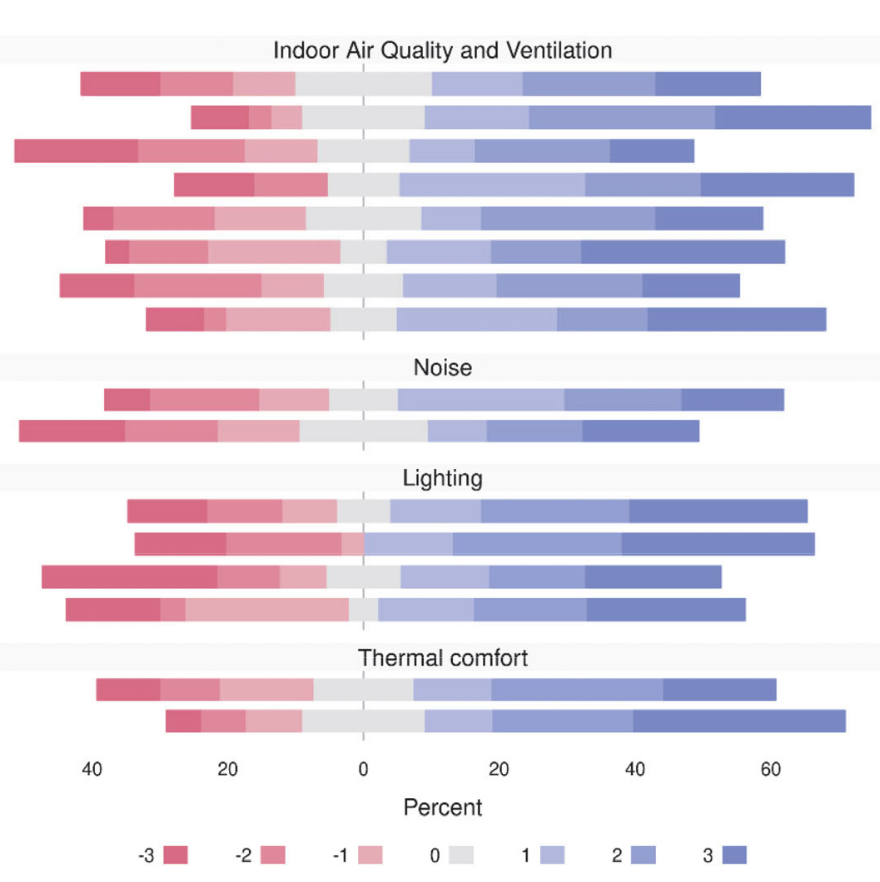 Indoor environment quality and work performance in “green” office buildings in the Middle EastRana Elknaklah, Daniel Fosas, and Sukumar NatarajanBuilding Simulation, 2020
Indoor environment quality and work performance in “green” office buildings in the Middle EastRana Elknaklah, Daniel Fosas, and Sukumar NatarajanBuilding Simulation, 2020Invited paper.
Globally, a primary concern is whether green office buildings perform as promised in terms of providing better indoor environment quality (IEQ) for employees, which may affect their satisfaction and work performance. In the Middle East, although there has been renewed interest in green building design, post occupancy evaluation of performance has never been conducted to-year, and evidence of actual occupant perception in green and non-green buildings is still ambiguous. Hence, we present the first study on IEQ performance in the Middle East. We show that Jordan can be taken as a representative example and systematically compare five “green” office buildings (representing 71% of all green-certified office buildings) against eight comparable conventional office buildings (CBs). Detailed bi-lingual survey data on perceived IEQ (n = 502) and work performance are accompanied by high-resolution continuous physical measurements of air temperature + relative humidity (n = 83) and CO2 concentrations (n = 21) with periodic measurements of mean radiant temperature and air speed, covering two typical summers and one typical winter. Results show both buildings types comply with design standards for indoor CO2 levels, while thermal comfort in green buildings is better than in CBs. However, CBs have a higher overall occupant satisfaction of IEQ. Work performance measured as absolute and relative absenteeism was slightly higher in CBs, with no significant differences in relative and absolute presenteeism between the two buildings types. These findings challenge the notion that green buildings improve occupant satisfaction and work performance over CBs and suggest the need for a better understanding of the performance-satisfaction gap.
@article{elknaklah2020poe, title = {Indoor environment quality and work performance in ``green'' office buildings in the Middle East}, journal = {Building Simulation}, author = {Elknaklah, Rana and Fosas, Daniel and Natarajan, Sukumar}, year = {2020}, } -
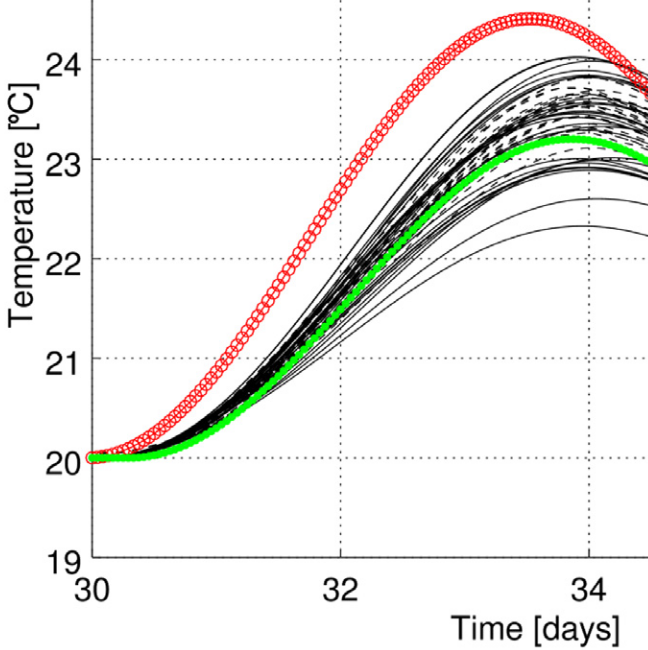 An analytical heat wave definition based on the impact on buildings and occupantsAlfonso Ramallo-Gonzalez, Matt E. Eames, Sukumar Natarajan, and 2 more authorsEnergy & Buildings, 2020
An analytical heat wave definition based on the impact on buildings and occupantsAlfonso Ramallo-Gonzalez, Matt E. Eames, Sukumar Natarajan, and 2 more authorsEnergy & Buildings, 2020Alongside a mean global rise in temperature, climate change predictions point to an increase in heat waves and an associated rise in heat-related mortality. This suggests a growing need to ensure buildings are resilient to such events. Unfortunately, there is no agreed way of doing this, and no standard set of heatwaves for scientists or engineers to use. In addition, in all cases, heat waves are defined in terms of external conditions, yet, as the Paris heat wave of 2003 showed, people die in the industrialised world from the conditions inside buildings, not those outside. In this work, we reverse engineer external temperature time series from monitored conditions within a representative set of buildings during a heat wave. This generates a general probabilistic analytical relationship between internal and external heatwaves and thereby a standard set of events for testing resilience. These heat waves are by their simplicity ideal for discussions between clients and designers, or for the setting of national building codes. In addition, they provide a new framework for the declaration of a health emergency.
@article{ramallo2020analytical, title = {An analytical heat wave definition based on the impact on buildings and occupants}, volume = {216}, journal = {Energy \& Buildings}, author = {Ramallo-Gonzalez, Alfonso and Eames, Matt E. and Natarajan, Sukumar and Fosas, Daniel and Coley, David A.}, year = {2020}, } -
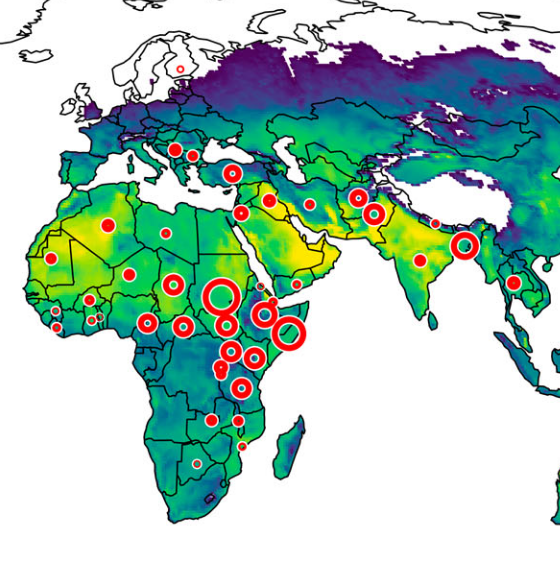 The importance of thermal modelling in transitional shelters designDaniel Fosas, Francis Moran, Sukumar Natarajan, and 2 more authorsBuilding Research & Information, 2020
The importance of thermal modelling in transitional shelters designDaniel Fosas, Francis Moran, Sukumar Natarajan, and 2 more authorsBuilding Research & Information, 2020More than 9 million people live in shelters globally, often in extremely hot climates. The thermal performance of shelters is often overlooked in the design process, despite being a consideration second only to safety in surveys of camp dwellers. Indeed, indoor temperatures exceeding 40 °C have been recorded. To aid in improving conditions, we examine the roles building simulation and prototyping could play in forecasting shelter thermal performance as part of a new shelter design process. The thermal performance of seven prototypes, built in the refugee camp of Azraq, was monitored during the hot season to test the suitability of four design approaches: (1) “blind” (uncalibrated) models, (2) calibrated models, (3) on-site prototypes and (4) off-site prototypes. These included the original shelter and six design alternatives implementing different overheating countermeasures. The results demonstrate that blind models are sensitive to the judgement of uncertainties but were still qualitatively useful. Model calibration vastly improves the agreement and significantly enhances forecasts of performance for the design alternatives, which remained similar across examined climates. We therefore conclude that simulation and prototyping, either on-site or off-site, should be adopted within the shelter design process before mass deployment, to create better living conditions for their dwellers.
@article{fosas2020importance, title = {The importance of thermal modelling in transitional shelters design}, journal = {Building Research \& Information}, volume = {48}, pages = {379--400}, author = {Fosas, Daniel and Moran, Francis and Natarajan, Sukumar and Orr, John and Coley, David A.}, year = {2020}, }
2018
-
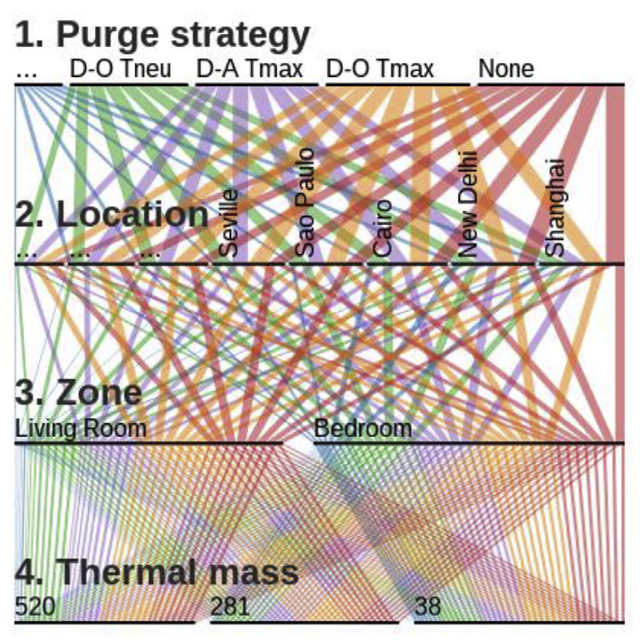 Mitigation versus Adaptation: Does Insulating Dwellings Increase Overheating Risk?Daniel Fosas, David A. Coley, Sukumar Natarajan, and 3 more authorsBuilding and Environment, 2018
Mitigation versus Adaptation: Does Insulating Dwellings Increase Overheating Risk?Daniel Fosas, David A. Coley, Sukumar Natarajan, and 3 more authorsBuilding and Environment, 2018Given climate change predictions of a warmer world, there is growing concern that insulation-led improvements in building fabric aimed at reducing carbon emissions will exacerbate overheating. If true, this would seriously affect building regulations all over the world which have moved towards increased insulation regimes. Despite extensive research, the literature has failed to resolve the controversy of insulation performance, primarily due to varied scope and limited comparability of results. We approach this problem through carefully constructed pairwise comparisons designed to isolate the effect of insulation on overheating. We encompass the complete range of relevant variables: latitude, climate, insulation, thermal mass, glazing ratio, shading, occupancy, infiltration, ventilation, orientation, and thermal comfort models — creating 576,000 building variants. Data mining techniques are implemented in a novel framework to analyse this large dataset. To provide confidence, the modelling was validated against data collected from well-insulated dwellings. Our results demonstrate that all parameters have a significant impact on overheating risk. Although insulation is seen to both decrease and increase overheating, depending on the influence of other parameters, parameter ranking shows that insulation only accounts for up to 5% of overall overheating response. Indeed, in cases that are not already overheating through poor design, there is a strong overall tendency for increased insulation to reduce overheating. These results suggest that, in cases with acceptable overheating levels (below 3.7%), the use of improved insulation levels as part of a national climate change mitigation policy is not only sensible, but also helps deliver better indoor thermal environments.
@article{fosas2018mitigation, title = {Mitigation versus Adaptation: Does Insulating Dwellings Increase Overheating Risk?}, volume = {143}, journal = {Building and Environment}, year = {2018}, pages = {740--759}, author = {Fosas, Daniel and Coley, David A. and Natarajan, Sukumar and Herrera, Manuel and Fosas-de-Pando, Miguel Angel and Ramallo-Gonzalez, Alfonso}, } -
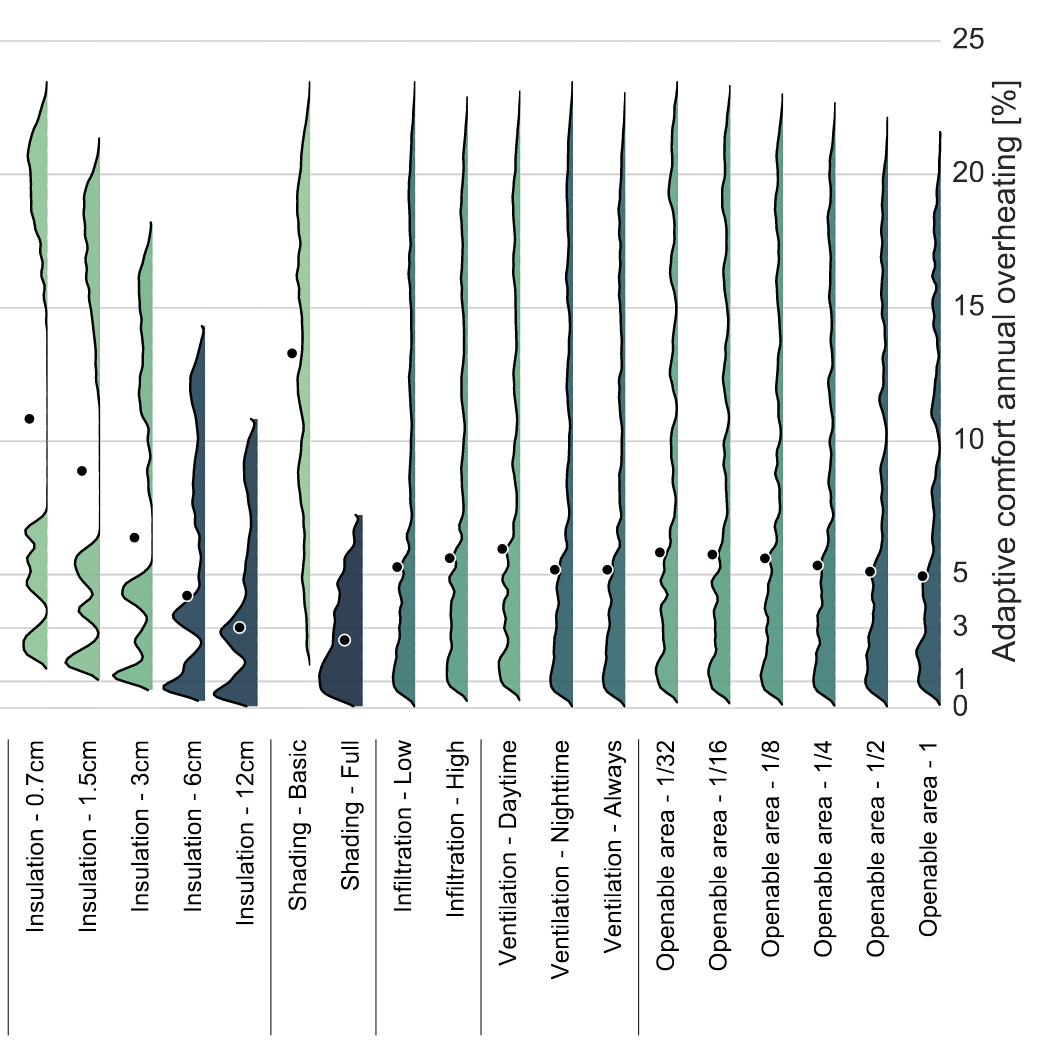 Refugee Housing through Cyclic DesignDaniel Fosas, Dima Albadra, Sukumar Natarajan, and 1 more authorArchitectural Science Review, 2018
Refugee Housing through Cyclic DesignDaniel Fosas, Dima Albadra, Sukumar Natarajan, and 1 more authorArchitectural Science Review, 2018Invited paper from Best Paper Award at PLEA 2017.
There are more than six million refugees living in camps globally, primarily in places with severe climates. While camps are planned to be temporary, they can be in use for decades. This ‘planned temporariness’, despite their potential longevity, together with the pressures of rapidly emerging situations, means the construction and monitoring of demonstrators is not a primary concern for their developers. This lack of iterative design improvement results in shelters with thermal environments far from ideal and a risk of increased morbidity. Here we propose a cyclical process for improving such shelters involving the thermal monitoring of pre-existing shelters to construct validated baseline simulation models of similar shelters in other areas of emerging crisis. These models can then be evolved and improved within an optimization cycle before mass-construction and field testing. Here we demonstrate the method for the case of Azraq camp in Jordan. Starting from an analysis of field survey data which exposes a high incidence of heat-stress experienced in the shelters, a series of architectural strategies are applied to the design, resulting in significant reductions in overheating. This work suggests that the proposed cyclical approach can lead to significant improvement in conditions currently experienced in refugee camp shelters.
@article{fosas2018cyclicdesign, title = {Refugee Housing through Cyclic Design}, volume = {61}, number = {5}, journal = {Architectural Science Review}, year = {2018}, pages = {327-337}, author = {Fosas, Daniel and Albadra, Dima and Natarajan, Sukumar and Coley, David A.}, }
2017
-
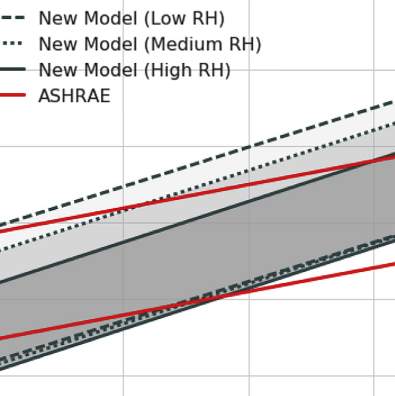 The influence of relative humidity on adaptive thermal comfortMarika Vellei, Manuel Herrera, Daniel Fosas, and 1 more authorBuilding and Environment, 2017
The influence of relative humidity on adaptive thermal comfortMarika Vellei, Manuel Herrera, Daniel Fosas, and 1 more authorBuilding and Environment, 2017Buildings generate nearly 30% of global carbon emissions, primarily due to the need to heat or cool them to meet acceptable indoor temperatures. In the last 20 years, the empirically derived adaptive model of thermal comfort has emerged as a powerful alternative to fixed set-point driven design. However, current adaptive standards offer a simple linear relationship between the outdoor temperature and the indoor comfort temperature, assumed to sufficiently explain the effect of all other variables, e.g. relative humidity (RH) and air velocity. The lack of a signal for RH is particularly surprising given its well-known impact on comfort. Attempts in the literature to either explain the lack of such a signal or demonstrate its existence, remain scattered, unsubstantiated and localised. In this paper we demonstrate, for the first time, that a humidity signal exists in adaptive thermal comfort using global data to form two separate lines of evidence: a meta-analysis of summary data from 63 field studies and detailed field data from 39 naturally ventilated buildings over 8 climate types. We implicate method selection in previous work as the likely cause of failure to detect this signal, by demonstrating that our chosen method has a 56% lower error rate. We derive a new designer-friendly RH-inclusive adaptive model that significantly extends the range of acceptable indoor conditions 2 for designing low-energy naturally-conditioned buildings all over the world. This is 1 demonstrated through parametric simulations in 13 global locations, which reveal that the 2 current model overestimates overheating by 30% compared to the new one.
@article{vellei2017influence, title = {The influence of relative humidity on adaptive thermal comfort}, journal = {Building and Environment}, volume = {124}, pages = {171--185}, year = {2017}, author = {Vellei, Marika and Herrera, Manuel and Fosas, Daniel and Natarajan, Sukumar}, } -
 Probabilistic adaptive thermal comfort for resilient designDavid A. Coley, Manuel Herrera, Daniel Fosas, and 2 more authorsBuilding and Environment, 2017
Probabilistic adaptive thermal comfort for resilient designDavid A. Coley, Manuel Herrera, Daniel Fosas, and 2 more authorsBuilding and Environment, 2017Adaptive thermal comfort theory has become the bedrock of much thinking about how to judge if a free-running environment is suitable for human occupation. In design work, the conditions predicted by a thermal model, when the model is presented with one possible annual weather time series (a reference year), are compared to the limits of human comfort. If the temperatures are within the comfort limits, the building is judged to be suitable. However, the weather in many locations can vary year-on-year by a considerable margin, and this begs the question, how robust are the predictions of adaptive comfort theory likely to be over the many years a building might be in use? We answer this question using weather data recorded for up to 30 years for locations within each of the five major Köppen climate classifications. We find that the variation in the annual time series is so great that the predicted comfort temperature frequently lies outside the acceptable range given by the reference year. Return periods for the excursions of the time series are calculated for each location. The results for one location are then validated using the world’s longest temperature record. These results suggest that industry and academia would be best advised to move to a probabilistic methodology, like the proposed one, when using adaptive comfort theory to judge the likely conditions within a building. Extra pertinence is provided by concerns over increases in mortality and morbidity in buildings due to a rapidly warming climate.
@article{coley2017probabilistic, title = {Probabilistic adaptive thermal comfort for resilient design}, journal = {Building and Environment}, volume = {123}, pages = {109--118}, year = {2017}, author = {Coley, David A. and Herrera, Manuel and Fosas, Daniel and Liu, Chunde and Vellei, Marika}, } -
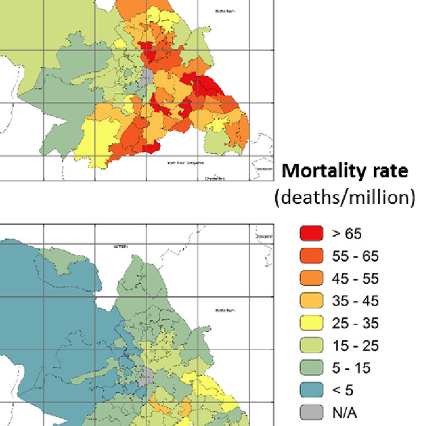 High resolution mapping of overheating and mortality riskChunde Liu, Tristan Kershaw, Daniel Fosas, and 3 more authorsBuilding and Environment, 2017
High resolution mapping of overheating and mortality riskChunde Liu, Tristan Kershaw, Daniel Fosas, and 3 more authorsBuilding and Environment, 2017Both the Paris heat wave of 2003 and recent high-resolution climate change predictions indicate a world where mortality from extreme weather events will increase. Most heat wave deaths occur in buildings, and are driven by the thermal characteristics of the buildings and their local environment. Unfortunately previous work on the topic has ignored such spatial variations by either assuming the climate has little variation over a large area, or using archetypes of buildings from stock models. The latter forgetting that neither building characteristics nor landscape context are uniform over a city, with for example suburbs having a different architecture and shading to the inner city. In this work we use a statistical method combined with a new remote surveying tool to assemble accurate models of real buildings across a landscape then map the spatial variability in overheating and excess deaths now and in the future at a resolution of 5km x 5km. High spatial variation in the risk of overheating and heat-related mortality was found due to the variability of architecture, context and weather. Variability from the architecture and shading context were found to be a greater influence on the spatial variation in overheating than climate variability. Overheating risk was found to increase significantly with heat-related mortality tripling by the 2050s. The method was validated against data collected during the northern hemisphere 2006 hot summer. The maps produced would be a highly useful resource for government in identifying populations of greatest concern when developing policies to combat such deaths.
@article{liu2017high, title = {High resolution mapping of overheating and mortality risk}, volume = {122}, pages = {1--14}, journal = {Building and Environment}, author = {Liu, Chunde and Kershaw, Tristan and Fosas, Daniel and Ramallo Gonzalez, Alfonso P. and Natarajan, Sukumar and Coley, David A.}, year = {2017}, } -
 A review of current and future weather data for building simulationManuel Herrera, Sukumar Natarajan, David A. Coley, and 5 more authorsBuilding Services Engineering Research and Technology, 2017
A review of current and future weather data for building simulationManuel Herrera, Sukumar Natarajan, David A. Coley, and 5 more authorsBuilding Services Engineering Research and Technology, 2017This article provides the first comprehensive assessment of methods for the creation of weather variables for use in building simulation. We undertake a critical analysis of the fundamental issues and limitations of each methodology and discusses new challenges, such as how to deal with uncertainty, the urban heat island, climate change and extreme events. Proposals for the next generation of weather files for building simulation are made based on this analysis. A seven-point list of requirements for weather files is introduced and the state-of-the-art compared to this via a mapping exercise. It is found that there are various issues with all current and suggested approaches, but the two areas most requiring attention are the production of weather files for the urban landscape and files specifically designed to test buildings against the criteria of morbidity, mortality and building services system failure
@article{herrera2017review, title = {A review of current and future weather data for building simulation}, author = {Herrera, Manuel and Natarajan, Sukumar and Coley, David A. and Kershaw, Tristan and Ramallo-González, Alfonso P. and Eames, Matt and Fosas, Daniel and Wood, Mike}, journal = {Building Services Engineering Research and Technology}, volume = {38}, pages = {602--627}, year = {2017}, }
conference articles
2025
-
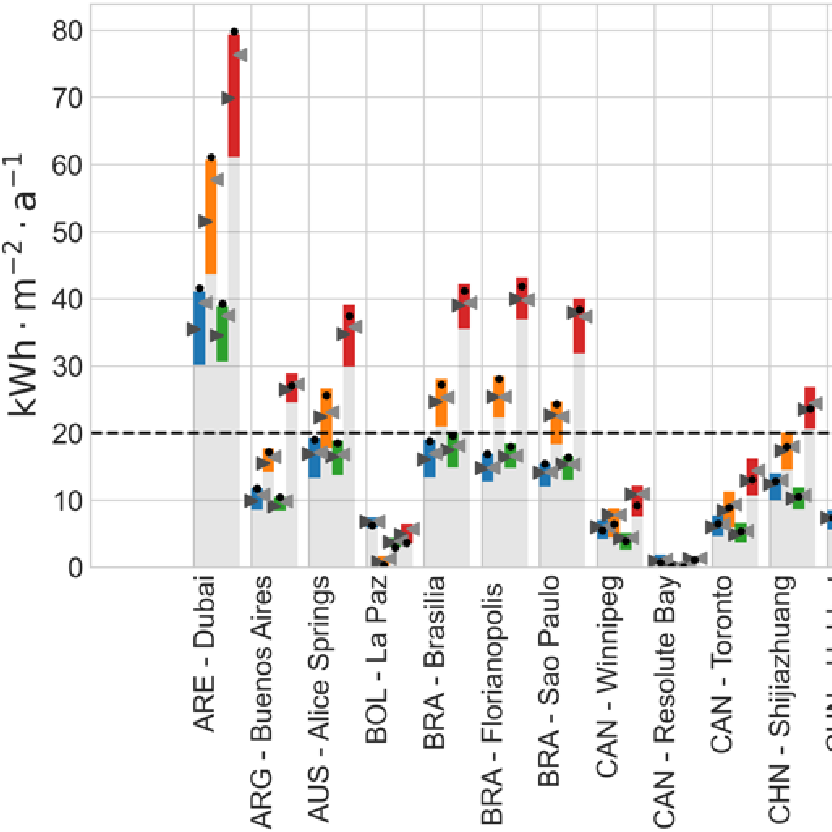 Bounding long-term building energy performance with single-year extreme weather filesDrury Crawley, Daniel Fosas, and Linda LawrieIn Proceedings of the 19th IBPSA Conference, Brisbane, Australia, Aug 24-27, 2025, Brisbane, 2025
Bounding long-term building energy performance with single-year extreme weather filesDrury Crawley, Daniel Fosas, and Linda LawrieIn Proceedings of the 19th IBPSA Conference, Brisbane, Australia, Aug 24-27, 2025, Brisbane, 2025The representation of typical weather conditions is well understood, but the resilient design and operation of buildings is influenced by extremes. Here, we advance the proposal of eXtreme Meteorological Years (XMYs), first introduced by Crawley & Lawrie in 2015, bounding the peak building energy performance for space heating and cooling with a single, composite year. Past XMYs formulations have been shown to work for several climates, but not all, and this work seeks to address this while improving XMYs performance. The novel quantile approach based on degree days shows that XMYs can bound energy performance within ±5 kWh·m²·a⁻¹. These results demonstrate XMYs can reliably bound performance to a degree compatible with decision-making for building design and operations.
@inproceedings{crawley2025xmy, title = {Bounding long-term building energy performance with single-year extreme weather files}, author = {Crawley, Drury and Fosas, Daniel and Lawrie, Linda}, eventtitle = {19th IBPSA Conference Brisbane, Australia, Aug 24-27, 2025}, booktitle = {Proceedings of the 19th IBPSA Conference, Brisbane, Australia, Aug 24-27, 2025}, location = {Brisbane}, year = {2025}, } -
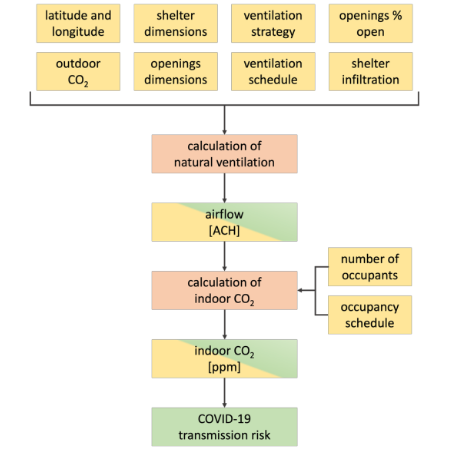 Proceedings of an ISIAQ International ConferenceAnna Conzatti, Noorullah Kuchai, Elif Keser, and 3 more authorsIn Proceedings of an ISIAQ International Conference, 8th-11th June 2025 Reykjavík University, Iceland, Reykjavík, 2025
Proceedings of an ISIAQ International ConferenceAnna Conzatti, Noorullah Kuchai, Elif Keser, and 3 more authorsIn Proceedings of an ISIAQ International Conference, 8th-11th June 2025 Reykjavík University, Iceland, Reykjavík, 2025Overcrowded humanitarian shelters often suffer from poor ventilation, leading to condensation, respiratory illnesses, and the spread of airborne diseases such as COVID-19. This study introduces SheltAir, the first co-created digital tool designed to help aid workers estimate natural ventilation rates, indoor CO₂ levels, and airborne disease transmission risks in shelters. The tool, developed in collaboration with 42 NGOs, utilizes approximately 20 input variables to model indoor air quality in over 3,100 global locations. SheltAir was validated against advanced network airflow models (EnergyPlus Airflow Network and Contam) using real shelter data from Ethiopia, Djibouti, and Nepal. Results indicate that SheltAir provides accurate CO₂ predictions while requiring no prior expertise in airflow modelling. Usability trials with 12 humanitarian workers showed that first-time users could simulate shelter ventilation within 30 minutes, improving efficiency in the field. The tool is currently being adopted for emergency response planning in Afghanistan.
@inproceedings{conzatti2025isiaq_sheltair, title = {Proceedings of an ISIAQ International Conference}, author = {Conzatti, Anna and Kuchai, Noorullah and Keser, Elif and Albadra, Dima and Fosas, Daniel and Coley, David}, eventtitle = {Healthy Buildings Europe 2025}, booktitle = {Proceedings of an ISIAQ International Conference, 8th-11th June 2025 Reykjavík University, Iceland}, location = {Reykjavík}, year = {2025}, }
2022
-
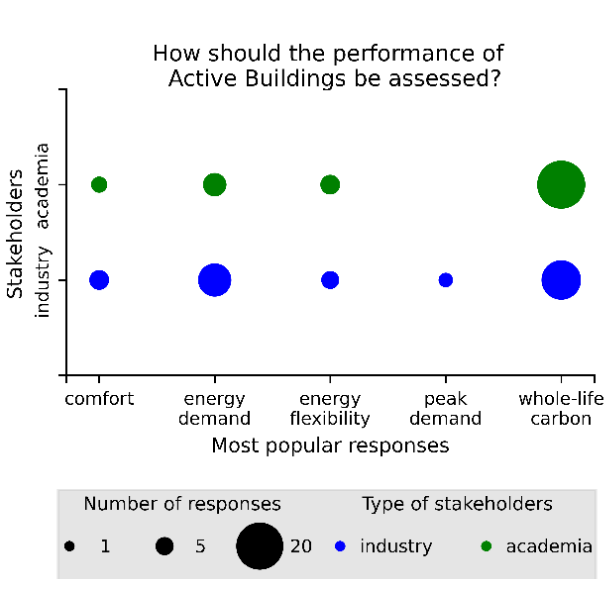 Going Active: How Do People Envision the next Generation of Buildings?Elli Nikolaidou, Ian Walker, David Coley, and 2 more authorsIn CLIMA 2022 Conference, Rotterdam, 2022
Going Active: How Do People Envision the next Generation of Buildings?Elli Nikolaidou, Ian Walker, David Coley, and 2 more authorsIn CLIMA 2022 Conference, Rotterdam, 2022Best Paper Award - Energy Theme at CLIMA2022 (Rotterdam).
With several countries having declared a climate emergency and set decarbonisation targets, the built environment is expected to change radically. Several building standards have been developed to reduce carbon dioxide emissions from buildings, but they do not provide a clear pathway to a net zero future. The recently launched Active Building Code (ABCode) offers guidance on minimising the environmental impact of the next generation of buildings termed Active Buildings (ABs). This is achieved through their synergetic relationship with the grid. This paper presents our two-stage investigation into the stakeholder perceptions of ABs. In stage 1, we collected thoughts on the future of the built environment through a series of online focus group discussions with 30 industry experts. In stage 2, we quantified the ideas that arose from stage 1 through an online survey of 30 academics and researchers. Participants answered four questions, namely: (i) what is missing from existing regulations and standards; (ii) what is an AB; (iii) how should the performance of ABs be assessed; and (iv) what are the challenges to the popularisation of ABs. The data that was collected from the focus groups and the survey was analysed visually and statistically using logistic regression to identify the aspects stakeholders find important when envisioning the next generation of buildings. No significant differences were, in general, observed between the two groups, with industry and academia agreeing that whole-life carbon, energy demand, and energy flexibility should be used for the performance assessment of ABs – therefore aligning with the metrics suggested by the ABCode. Both groups interpreted ‘activeness’ as responsiveness, with industry experts highlighting the need to better define the relationship between buildings and the grid. They also regarded people’s mindset as the biggest challenge faced by ABs, due to the general tendency to make decisions based on capital cost. Academics and researchers also worried about the cost of technologies involved, which is however expected to drop over time. Results should be used to inform regulations and standards to make sure these are comprehended by all stakeholders and ultimately drive down carbon on all building projects.
@inproceedings{nikolaidou2022abcode, title = {Going Active: How Do People Envision the next Generation of Buildings?}, author = {Nikolaidou, Elli and Walker, Ian and Coley, David and Allen, Stephen and Fosas, Daniel}, eventtitle = {CLIMA 2022 the 14th HVAC World Congress}, booktitle = {CLIMA 2022 Conference}, location = {Rotterdam}, year = {2022}, }
2021
-
 Indoor air quality in refugee shelters: an exploratory study on the potential of improved shelter designAnna Conzatti, Noorullah Kuchai, and Daniel FosasIn Proceedings of Comfort At The Extremes, CATE’21, Muscat, 2021
Indoor air quality in refugee shelters: an exploratory study on the potential of improved shelter designAnna Conzatti, Noorullah Kuchai, and Daniel FosasIn Proceedings of Comfort At The Extremes, CATE’21, Muscat, 2021There are more than eighty million forcibly displaced people worldwide and more than twenty-six million are refugees. Often, these refugees are encamped in temporary shelters consisting of one or two rooms, where all the daily activities, such as cooking and sleeping, occur. This paper focuses on the indoor air quality (IAQ) of shelters in Hitsats refugee camp (Ethiopia), where refugees use traditional charcoal stoves for cooking and heating and shelters are extremely overcrowded. Therefore, the indoor use of solid fuel and the high number of occupants resulted in poor indoor air quality. Despite limited access to the camp, the indoor concentration of carbon dioxide (CO2) was measured using spot measurements in winter and summer in 286 permanent shelters and used to estimate CO2 concentration and ventilation rate. In this study, the indoor concentration of carbon dioxide has been used to investigate airflow efficiency in refugee shelters and to predict the quality of indoor air. The results indicate very poor air quality, especially during the night. Low levels of airflow resulted in potentially health-threatening indoor levels of CO2. The study suggests further investigation of resilient solutions for enhancing airflow while maintaining improved IAQ, indoor thermal comfort, and not compromising the security of the dwellers.
@inproceedings{conzatti2021iaq, title = {Indoor air quality in refugee shelters: an exploratory study on the potential of improved shelter design}, author = {Conzatti, Anna and Kuchai, Noorullah and Fosas, Daniel}, eventtitle = {Comfort At The Extremes 2021}, booktitle = {Proceedings of Comfort At The Extremes, CATE'21}, location = {Muscat}, year = {2021}, pages = {161--169}, }
2020
-
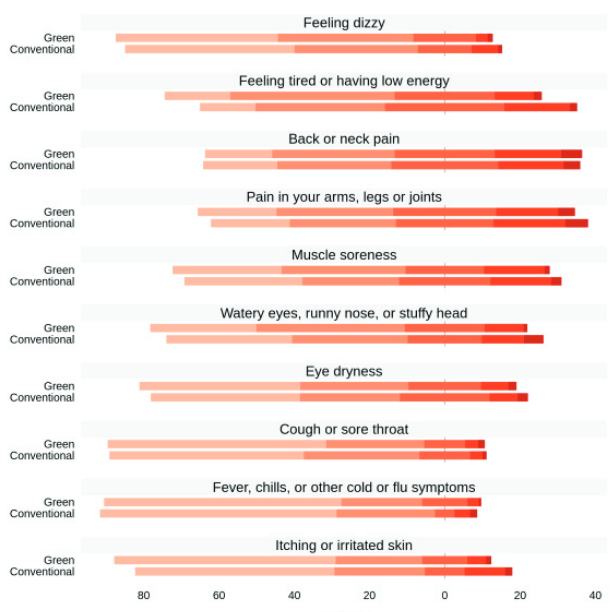 Are Green Buildings Doing Enough? The role of green certification and gender on sick building syndromeRana Elknaklah, Daniel Fosas, and Sukumar NatarajanIn Proceedings of the 35th PLEA Conference on Passive and Low Energy Architecture, A Coruña, 2020
Are Green Buildings Doing Enough? The role of green certification and gender on sick building syndromeRana Elknaklah, Daniel Fosas, and Sukumar NatarajanIn Proceedings of the 35th PLEA Conference on Passive and Low Energy Architecture, A Coruña, 2020One of the promised benefits of green buildings is providing healthier indoor environments for their occupants, however, this notion is still debated. To test this, a sample of 502 office-based workers from 13 airconditioned office buildings (44.4% female and 55.6% male) in Jordan completed a questionnaire on Sick Building Syndrome (SBS) symptoms. The role played by gender in symptom-reporting was also investigated. Findings showed that building type made no significant difference to the prevalence of all SBS symptoms except the tiredness symptom which was slightly higher in the occupants of conventional buildings. Surprisingly, green buildings and conventional buildings had a higher occurrence of SBS symptoms than what industry standards allow for (up to 20%), suggesting that both building types would be classified as sick buildings. Results have also shown that the only significant difference between male and female workers was in the cough and sore throat symptom, which was reported more often by female workers. These findings reinforce the need for further attention to the occupants’ perceived health in the green buildings, which may use as an indict of the building performance.
@inproceedings{elknaklah2020plea, title = {Are Green Buildings Doing Enough? The role of green certification and gender on sick building syndrome}, author = {Elknaklah, Rana and Fosas, Daniel and Natarajan, Sukumar}, eventtitle = {35th PLEA Conference on Passive and Low Energy Architecture}, booktitle = {Proceedings of the 35th PLEA Conference on Passive and Low Energy Architecture}, location = {A Coruña}, year = {2020}, pages = {193--198}, }
2019
-
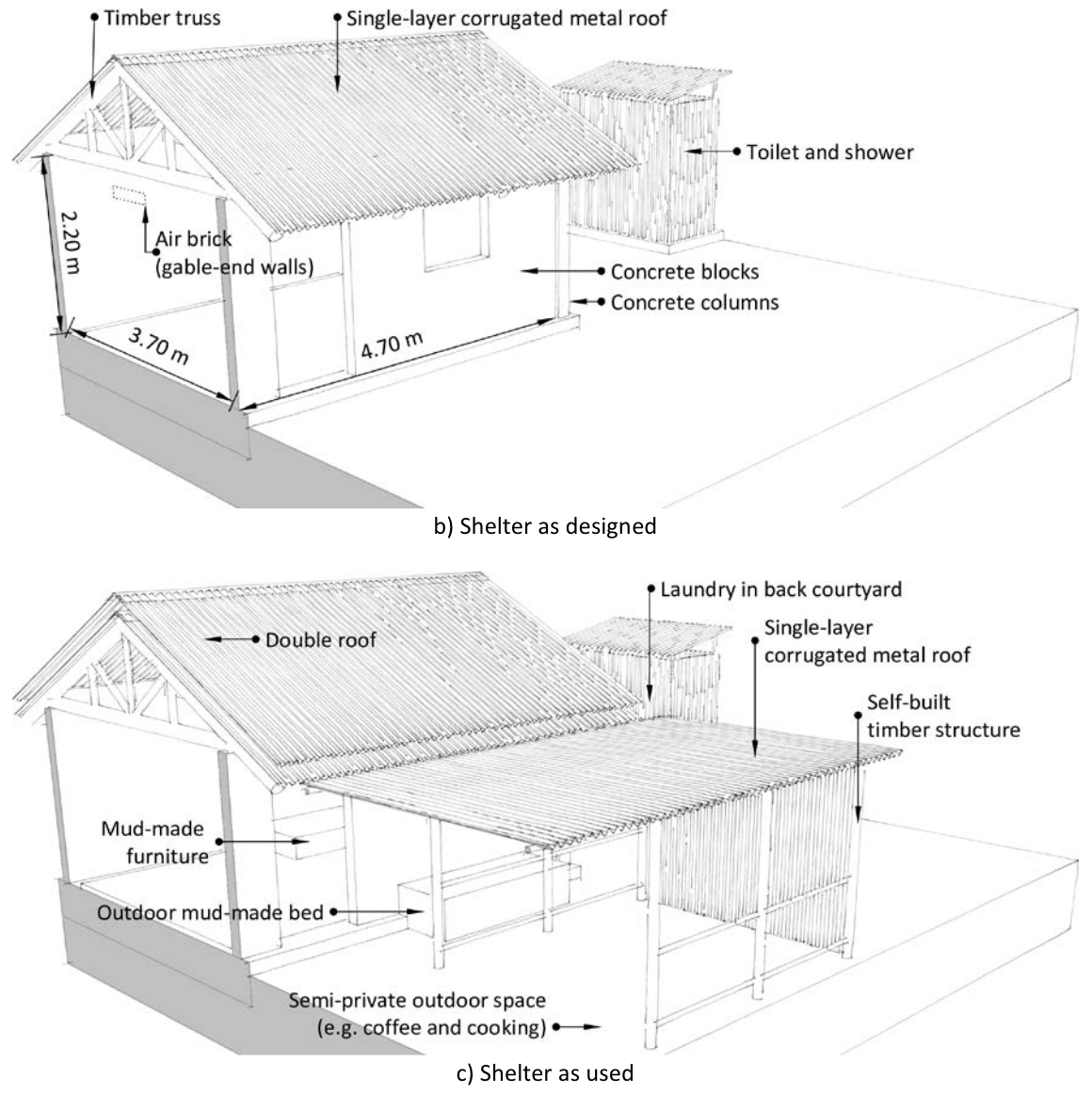 Reclaiming Refugee Agency and Its Implications for Shelter Design in Refugee CampsNatalia Paszkiewicz and Daniel FosasIn Proceedings of the 1st International Conference on: Comfort at the Extremes: Energy, Economy and Climate, Dubai, 2019
Reclaiming Refugee Agency and Its Implications for Shelter Design in Refugee CampsNatalia Paszkiewicz and Daniel FosasIn Proceedings of the 1st International Conference on: Comfort at the Extremes: Energy, Economy and Climate, Dubai, 2019Refugee agency refers to the notion of decision making exercised by forced migrants, and their efforts aimed at improving life in the context of displacement. As such, it has emerged as a useful concept to channel discussions about the challenges of current refugee encampment practices, which we argue encompasses consequences for the design and provision of shelter solutions. Building on the evidence collected in selected refugee camps of Jordan and Ethiopia, we suggest that acknowledging and incorporating the voices of refugees can not only enhance their well-being in climatically, socially and politically challenging environments, but it could also be beneficial to other actors such as humanitarian agencies and host governments. While we recognize the constrains arising in these contexts, we focus on the importance of adaptations and customization of shelters that we found to be the leitmotiv and, more critically, a fundamental humanizing factor of refugee experience in camps. The refugees’ freedom to make choices about their own shelters can then be used to rethink how to deliver better environments in which camp inhabitants can live in dignity. Although engineering design can only facilitate agency, rather than give it, it could help build the consensus about the pre-requisites of what constitutes truly ‘appropriate’ shelters.
@inproceedings{paszkiewicz2019reclaiming, title = {Reclaiming Refugee Agency and Its Implications for Shelter Design in Refugee Camps}, booktitle = {Proceedings of the 1st {{International Conference}} on: {{Comfort}} at the {{Extremes}}: {{Energy}}, {{Economy}} and {{Climate}}}, author = {Paszkiewicz, Natalia and Fosas, Daniel}, year = {2019}, pages = {584--594}, publisher = {Ecohouse Initiative Ltd}, location = {Dubai}, eventtitle = {International Conference on: Comfort at the Extremes: Energy, Economy and Climate}, }
2018
-
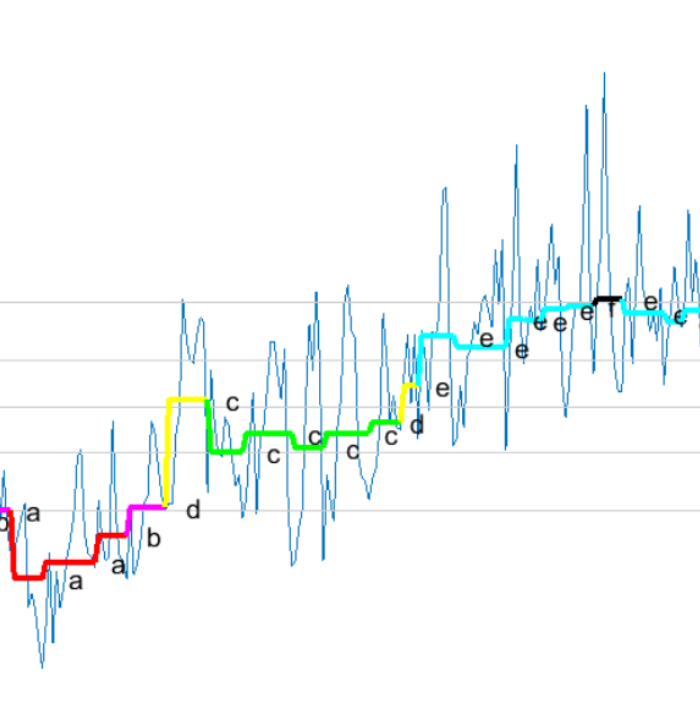 Adaptive Piecewise and Symbolic Aggregate Approximation as an Improved Representation Method for Heat Waves DetectionAida Ferreira, Iona Rameh Barbosa, Ronaldo Aquino, and 4 more authorsIn Intelligent Computing, London, 2018
Adaptive Piecewise and Symbolic Aggregate Approximation as an Improved Representation Method for Heat Waves DetectionAida Ferreira, Iona Rameh Barbosa, Ronaldo Aquino, and 4 more authorsIn Intelligent Computing, London, 2018Mining time series has attracted an increasing interest due to its wide applications in finance, industry, biology, environment, and so on. In order to reduce execution time and storage space, many high level representations or abstractions of the raw time series data have been proposed including Discrete Fourier Transform (DFT), Discrete Wavelet Transform (DWT), Piecewise Aggregate Approximation (PAA) and Symbolic Aggregate approXimation (SAX). In this paper, we introduce a novel adaptive piecewise and symbolic aggregate approximation (APAA/ASAX) which creates segments of variable length in order to automatically adapts any segment length to its local condition of variability and difference to the average value of the current values in which the segment is defined. The average of each variable segment length from APAA is represented as a symbol from an ordered alphabet generating a modified version for SAX called adaptive SAX (ASAX). This straightforwardly allows to handle a more versatile definition for the event duration. The method APAA/ASAX was used for locating heat waves patterns in a realworld time series datasets of daily temperature information, from the year 1970 until 2009. The experimental results show that APAA/ASAX representation was able to locate heatwave events in a huge databases. Advantages of APAA regarding traditional PAA are mainly based on being constrain-free of fixed schemes of segment length. It also highlights the ability of self-tuning this length depending on local time series characteristics. This means that for flat time series APAA proposes a lower number of segments to reduce dimensionality than in the case to deal with time series of high variability. The approach will be of use to those looking extreme events in any time series.
@inproceedings{ferreira2018adaptivepiecewisesymbolic, location = {London}, title = {Adaptive Piecewise and Symbolic Aggregate Approximation as an Improved Representation Method for Heat Waves Detection}, booktitle = {Intelligent Computing}, year = {2018}, author = {Ferreira, Aida and Rameh Barbosa, Iona and Aquino, Ronaldo and Herrera, Manuel and Natarajan, Sukumar and Fosas, Daniel and Coley, David}, } -
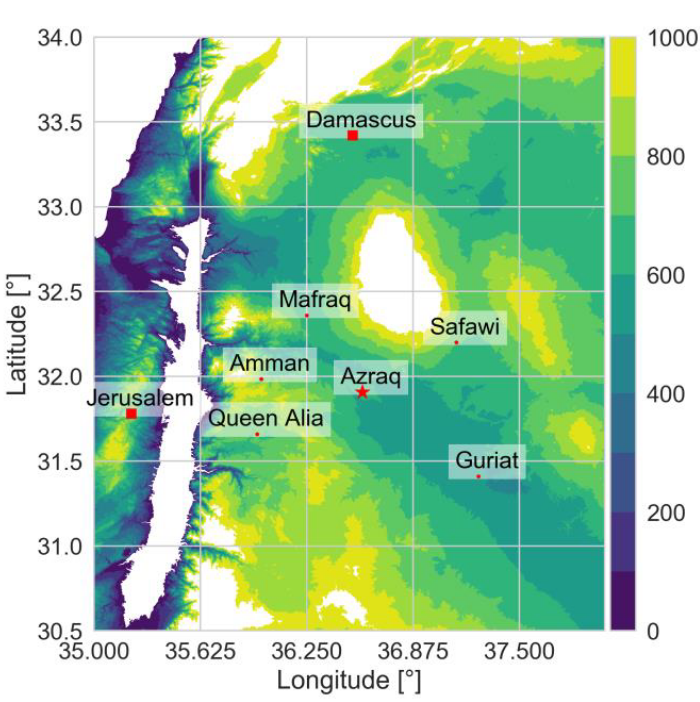 Weather Files for Remote Places: Leveraging Reanalyses and Satellite DatasetsDaniel Fosas, Manuel Herrera, Sukumar Natarajan, and 1 more authorIn 1st International Conference on Data for Low Energy Buildings, Murcia, 2018
Weather Files for Remote Places: Leveraging Reanalyses and Satellite DatasetsDaniel Fosas, Manuel Herrera, Sukumar Natarajan, and 1 more authorIn 1st International Conference on Data for Low Energy Buildings, Murcia, 2018Weather files capture the time-varying conditions under which buildings perform and, as such, they constitute one of the fundamental inputs for building performance simulation. In theory, the creation of weather files only requires collecting data at a certain frequency for a key number of variables during the time of interest. In practice, several problems arise. Direct measurement on a project basis can be a costly operation considering the site accessibility and the number of instruments needed to collect complete weather observations. Sometimes, this is simply impossible if a study requires historical data. These issues are traditionally overcome using the weather data collected at a nearby public weather stations, but this can be equally challenging, or even impossible, depending on how far away the station is and the frequency and completeness of observations. Arising from the need to simulate the thermal performance of buildings at remote locations, this study presents an approach to generate weather files based on satellite imaging and reanalysis datasets. Given the good agreement with local station’s observations, it is shown how these publicly available datasets can be combined to create weather files suitable for building performance simulation. This is applied to a case study to compare the performance of a building and its systems against traditional weather files. The work quantifies and discusses the discrepancy obtained between the different sources. Overall, results indicate that satellite and reanalysis datasets constitute a suitable resource to create weather files for building performance simulation.
@inproceedings{fosas2018weatherfilesremote, location = {Murcia}, title = {Weather Files for Remote Places: Leveraging Reanalyses and Satellite Datasets}, eventtitle = {1st International Conference on Data for Low Energy Buildings}, booktitle = {1st International Conference on Data for Low Energy Buildings}, publisher = {University of Murcia}, year = {2018}, author = {Fosas, Daniel and Herrera, Manuel and Natarajan, Sukumar and Coley, David A}, } -
 Enhancing Predictive Models for Short-Term Forecasting Electricity Consumption in Smart BuildingsManuel Herrera, Daniel Fosas, Bruno M. Beltran, and 1 more authorIn 1st International Conference on Data for Low Energy Buildings, Murcia, 2018
Enhancing Predictive Models for Short-Term Forecasting Electricity Consumption in Smart BuildingsManuel Herrera, Daniel Fosas, Bruno M. Beltran, and 1 more authorIn 1st International Conference on Data for Low Energy Buildings, Murcia, 2018Lighting, heating, and air conditioning systems are instances of how electricity use at buildings is of key importance for occupants comfort and well-being. Since the electricity can be produced but cannot be stored, for utility companies it is important to reliably forecast energy supply almost in near real-time. Nowadays, smart grid technologies development also require a high resolution forecasting to eliminate blackouts and to optimally adapt energy supply to customers’ needs. These are the reasons why the finest Machine Learning and Data Science based methods have been developed and applied to approach as much accurate as possible predictive models for short-term electricity consumption. This paper proposes to enhance those predictive models by using weather and calendar information to configure a more complete working database. In addition, a cluster-based forecasting methodology will augment any predictive model with learning from other buildings. Thus, predicting future values for one smart meter is approached by utilising not only its own historical electricity consumption values, but working with a multivariate time series on weather and calendar data and information from other buildings at the same cluster. This proposal has been tested with measures from smart meters collected every 30 minutes during one year for 5 selected buildings in Bristol (UK). The enhancing methodology can predict electricity consumption data with higher accuracy than using data from just one building.
@inproceedings{herrera2018enhancingpredictivemodels, location = {Murcia}, title = {Enhancing Predictive Models for Short-Term Forecasting Electricity Consumption in Smart Buildings}, eventtitle = {1st International Conference on Data for Low Energy Buildings}, booktitle = {1st International Conference on Data for Low Energy Buildings}, publisher = {University of Murcia}, year = {2018}, author = {Herrera, Manuel and Fosas, Daniel and Beltran, Bruno M. and Coley, David A}, }
2017
-
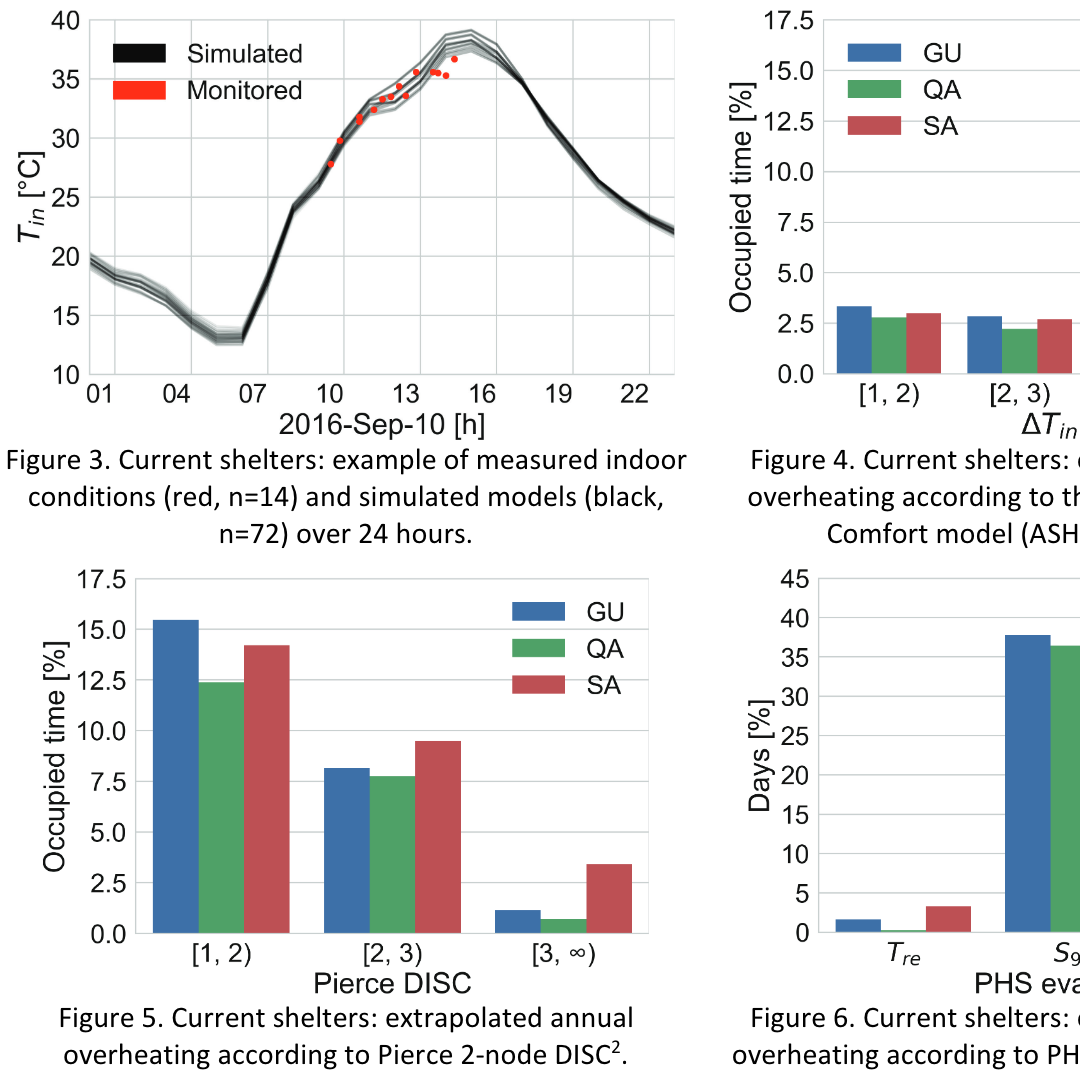 Overheating and health risks in refugee shelters: assessment and relative importance of design parametersDaniel Fosas, Dima Albadra, Sukumar Natarajan, and 1 more authorIn Proceedings of the 33rd PLEA International Conference: Design to Thrive, Edinburgh, 2017
Overheating and health risks in refugee shelters: assessment and relative importance of design parametersDaniel Fosas, Dima Albadra, Sukumar Natarajan, and 1 more authorIn Proceedings of the 33rd PLEA International Conference: Design to Thrive, Edinburgh, 2017Best Paper Award at PLEA2017 (Edinburgh).
There are now more than four million refugees living in camps around the world. The majority of such camps are within inhospitable environments, often with extreme climates. This paper focuses on the thermal conditions of shelters in the Azraq refugee camp (Jordan), subject to an arid climate with high temperatures during the hot season. Due to political and other sensitivities, whole-, or multi-year monitoring of occupied shelters—and hence the empirical determination of overheating—is difficult. Instead, internal conditions in the shelters were monitored for three weeks in summer and used to validate computer models of the accommodation. These models were then used to generate annual predictions of overheating assessed through overheating criteria based on thermal discomfort and physiological indicators of heat stress. Building on these results, the performance of alternative designs specifications or shelter operation strategies were investigated through parametric analysis. The results show max imum indoor temperatures over 45°C. Overheating thresholds were exceeded for more than 20% of the year and physiological indicators suggest the possibility of health-threatening conditions. The use of alternative designs and strategies reduced overheating to nearly 2% of the year, with a steep reduction of severe heat stress indicators.
@inproceedings{fosas2017shelters, location = {Edinburgh}, title = {Overheating and health risks in refugee shelters: assessment and relative importance of design parameters}, author = {Fosas, Daniel and Albadra, Dima and Natarajan, Sukumar and Coley, David A}, editor = {Brotas, Luisa and Roaf, Susan and Nicol, Fergus}, eventtitle = {PLEA 2017}, booktitle = {Proceedings of the 33rd PLEA International Conference: Design to Thrive}, volume = {3}, pages = {3746--3753}, year = {2017}, organization = {NCEUB 2017}, } -
 Minimising Overheating in Passive and Low Energy Buildings Using Kriging-Based Inverse Modelling TechniquesMike Wood, Matthew Eames, Daniel Fosas, and 1 more authorIn Proceedings of the 33rd PLEA International Conference: Design to Thrive, Edinburgh, 2017
Minimising Overheating in Passive and Low Energy Buildings Using Kriging-Based Inverse Modelling TechniquesMike Wood, Matthew Eames, Daniel Fosas, and 1 more authorIn Proceedings of the 33rd PLEA International Conference: Design to Thrive, Edinburgh, 2017Preventing summertime overheating within passive buildings is important for the comfort of the occupants. The likelihood that a building will overheat depends on several factors, including the form of the building, the percentage glazing and the building’s thermal mass and insulation. Furthermore, the amount of overheating depends on the criteria we use to measure it. We investigate the CIBSE TM52 overheating criteria and look at how they are affected by changes in the design of a PassivHaus style building. We calculate the percentage of possible buildings that pass each of the three CIBSE criteria using the Gaussian process regression-based efficient global inversion (EGI) technique. Our work is divided into two stages. First, we look at the sensitivity of the overheating criteria to the design (i.e. examining the building parameters that have the greatest effect on the overheating criteria). Second, we calculate the percentage of all possible building designs that meet these criteria using the EGI technique. This method provides an estimation of whether a building design will meet a criterion. This surrogate modelling method can be very accurate because the EGI technique ‘tunes’ the Gaussian process regression model to determine whether variables exceed a threshold. We explore the overheating criteria for 60,000 potential building designs. Our findings show that the relative glazed area has the greatest influence on the overheating criteria, whereas properties such as thermal mass and insulation have less effect than expected. Further work is needed to explore the effects on different building types in other climates.
@inproceedings{wood2017kriging, location = {Edinburgh}, title = {Minimising Overheating in Passive and Low Energy Buildings Using Kriging-Based Inverse Modelling Techniques}, volume = {3}, isbn = {978-0-9928957-5-4}, eventtitle = {PLEA 2017}, booktitle = {Proceedings of the 33rd PLEA International Conference: Design to Thrive}, publisher = {NCEUB 2017}, year = {2017}, pages = {3826--3833}, author = {Wood, Mike and Eames, Matthew and Fosas, Daniel and Coley, David}, editor = {Brotas, Luisa and Roaf, Susan and Nicol, Fergus}, }
2016
-
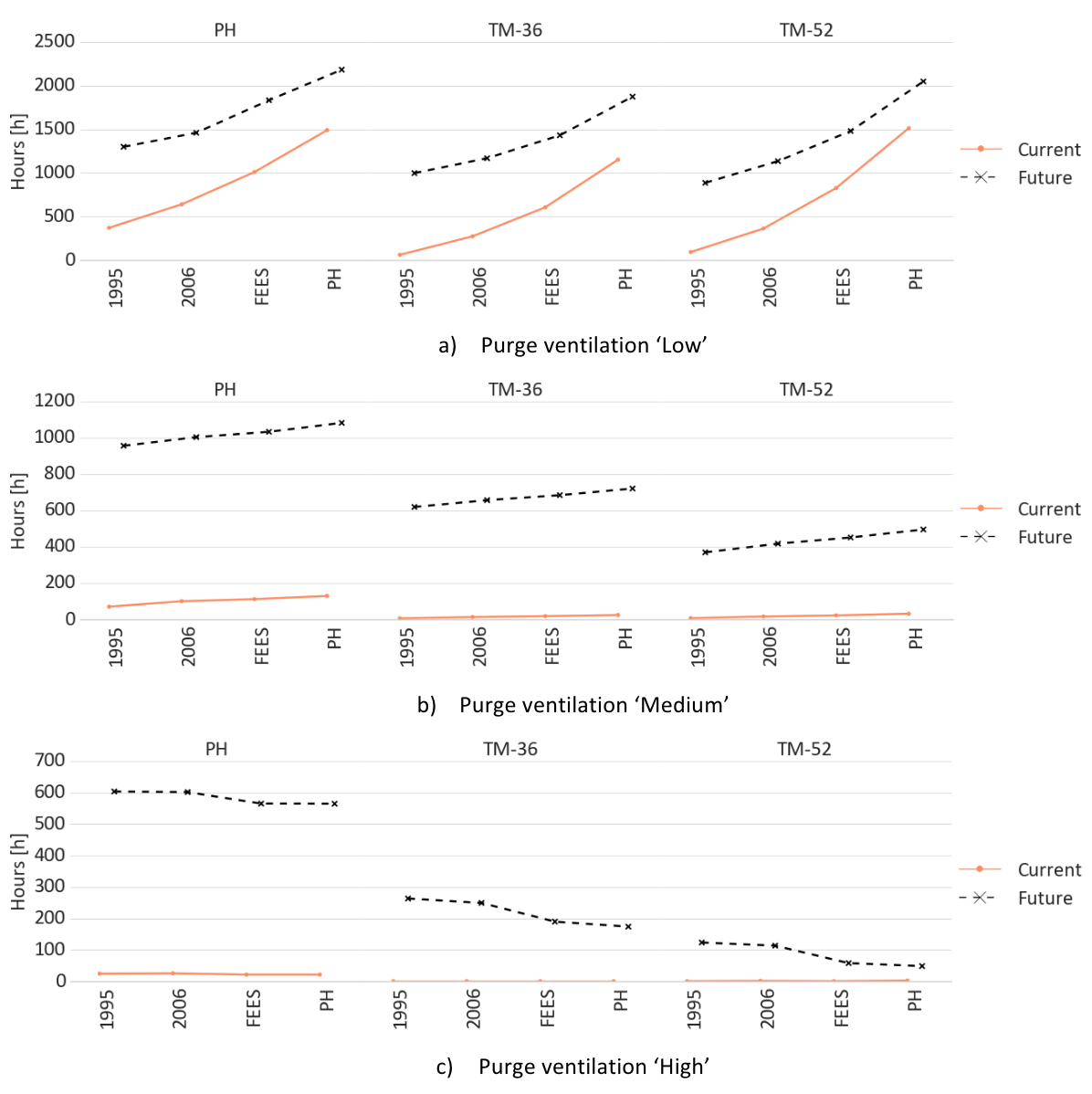 Influence of overheating criteria in the appraisal of building fabric performanceDaniel Fosas, Sukumar Natarajan, David A. Coley, and 2 more authorsIn 9th Windsor Conference: Making Comfort Relevant, Windsor, 2016
Influence of overheating criteria in the appraisal of building fabric performanceDaniel Fosas, Sukumar Natarajan, David A. Coley, and 2 more authorsIn 9th Windsor Conference: Making Comfort Relevant, Windsor, 2016In response to the threat of anthropogenic climate change, heating dominated countries have focused on reducing the space conditioning demand by increasing insulation and airtightness. However, given climate projections and lifespan of buildings, concerns have arisen on whether these strategies deliver resilient solutions. As overheating can be evaluated through different criteria, this paper investigates if building fabric performance is subject to bias from the assessment method chosen and account for discrepancies between previous studies. To answer this, we modelled dwellings compliant with 1995 and 2006 UK building regulations and the FEES and Passivhaus standards in a consistent and realistic manner. The parametric study included different weathers, thermal mass, glazing ratios, shading strategies, occupancy profiles, infiltration levels, purge ventilation strategies and orientations, resulting in 16128 simulation models. To provide confidence in the output, the base model was first validated against data collected from a real well-insulated dwelling. Results show that the benchmark choice is influential in the evaluation of building fabric performance as it is able to inverse overheating trends. Criteria based on adaptive comfort best represented expected behaviour, where improved building fabric is a resilient measure that reduces overheating as long as occupants are able to open windows for ventilation.
@inproceedings{fosas2016influence, location = {Windsor}, title = {Influence of overheating criteria in the appraisal of building fabric performance}, author = {Fosas, Daniel and Natarajan, Sukumar and Coley, David A. and Ramallo-González, Alfonso P. and Fosas de Pando, Miguel}, booktitle = {9th Windsor Conference: Making Comfort Relevant}, pages = {1078--1098}, year = {2016}, organization = {NCEUB}, }
reports
2023
-
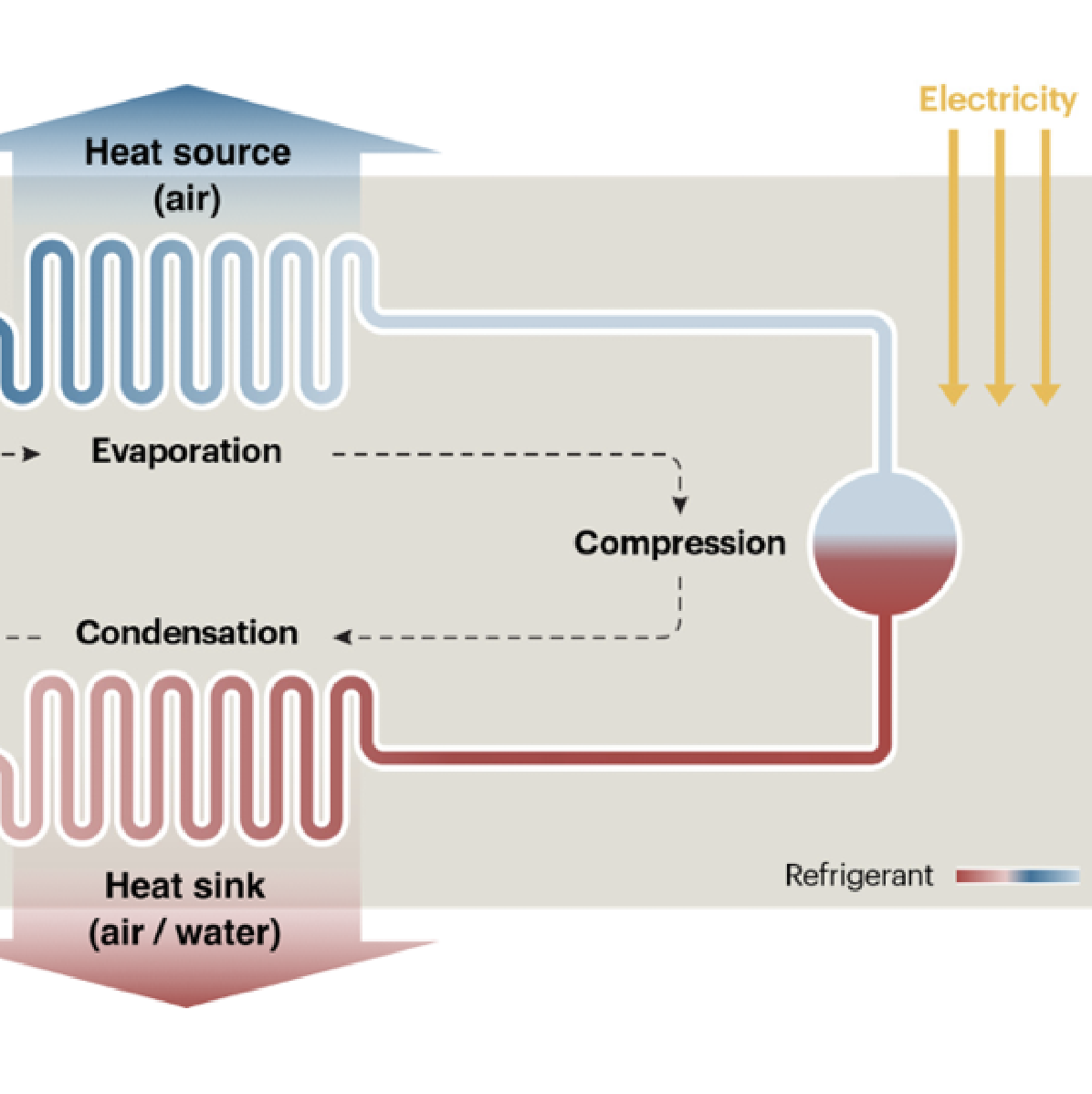 Models to evaluate the performance of air-source heat pump systems in UK homesDaniel Fosas2023
Models to evaluate the performance of air-source heat pump systems in UK homesDaniel Fosas2023This report explores modelling approaches to predict, understand and improve the performance of air source heat pumps for domestic properties in the UK. It starts with the introduction to the UK domestic sector and heat pump technology. Next, the design principles for space conditioning and domestic hot water systems are presented. This is followed by the evaluation of established professional practice and alternatives available in the field. Lastly, the current landscape for heat pump technology in the UK is contrasted with the opportunities advanced modelling techniques offer for successful rollout of heat pump technology.
2020
-
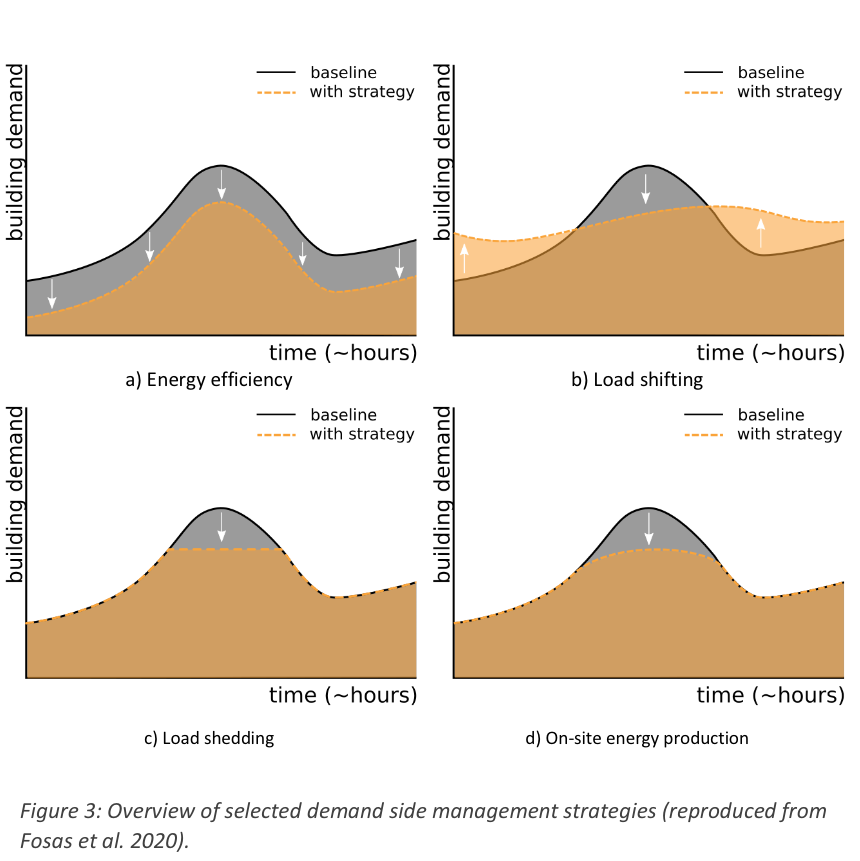 Buildings as Energy Infrastructure, not Passive ConsumersElli Nikolaidou, Daniel Fosas, Matthew Roberts, and 3 more authors2020
Buildings as Energy Infrastructure, not Passive ConsumersElli Nikolaidou, Daniel Fosas, Matthew Roberts, and 3 more authors2020It is clear that the energy infrastructure of the UK will be transformed over the next thirty years. The legal requirement to decarbonise and switch to renewables implies, with the possible exception of nuclear, an increasing move from a centralised to a decentralised energy system. In part, this is due to the fact that the energy density of renewables can be lower than that of traditional power stations, which can result in a mass adoption and hence thousands or even millions of suppliers. At the same time, moving from carbon-based fuels to a largely electrical future offers the possibility of large bi-directional flows, which in turn makes it difficult to separate users from suppliers. A simple example being an electric car, which at different times of the day might be a source of propulsion, a store for excess renewable energy or even a supplier of electricity. This new world of bi-directional flows means that the UK will have to re-write the rules on everything from tariff structures to the wiring of cities.
@report{nikolaidou2020abcsota, title = {Buildings as Energy Infrastructure, not Passive Consumers}, author = {Nikolaidou, Elli and Fosas, Daniel and Roberts, Matthew and Allen, Stephen and Walker, Ian and Coley, David A.}, institution = {Active Building Centre}, year = {2020}, }
2019
-
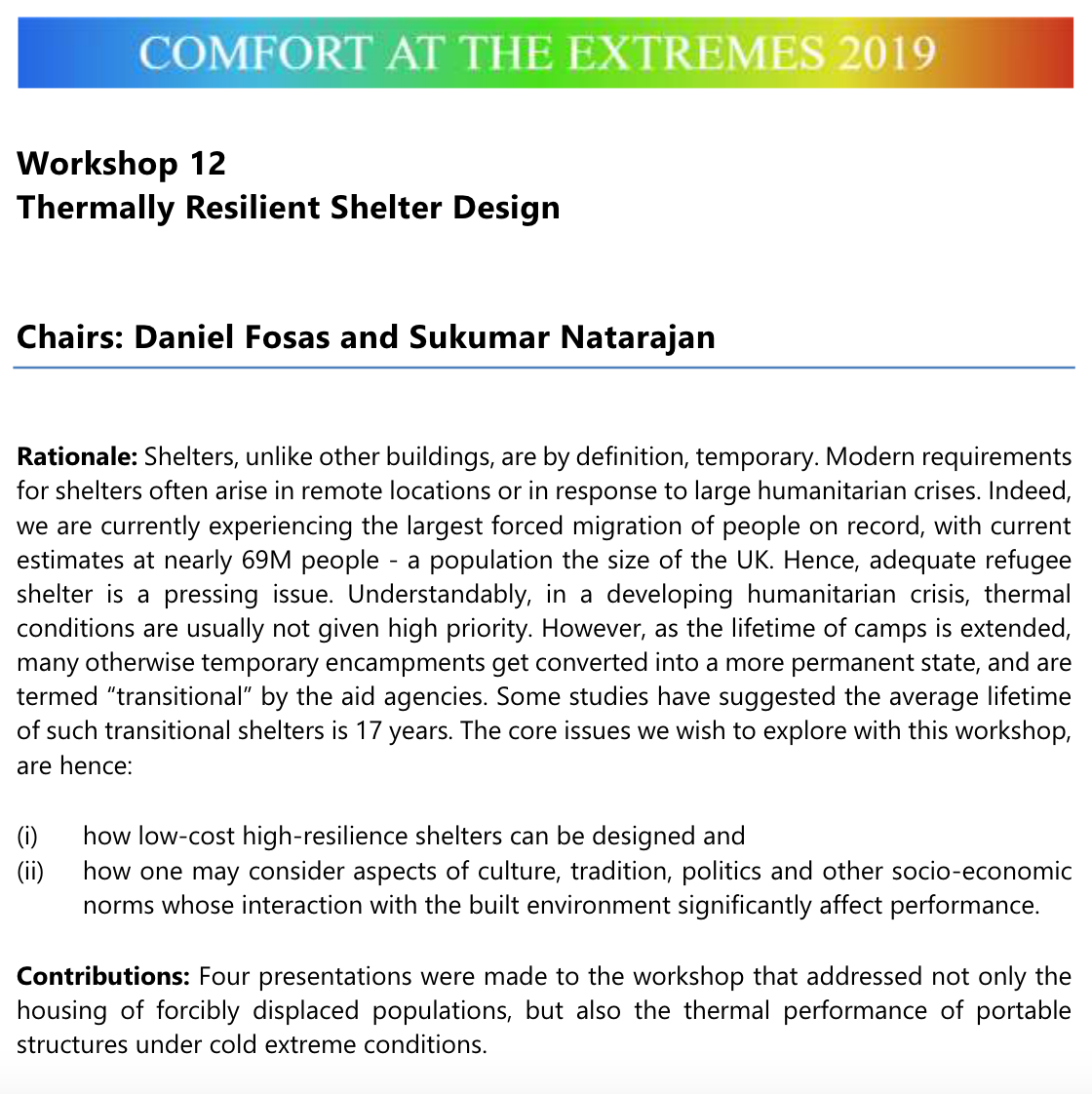 Thermally Resilient Shelter DesignDaniel Fosas and Sukumar Natarajan2019
Thermally Resilient Shelter DesignDaniel Fosas and Sukumar Natarajan2019Shelters, unlike other buildings, are by definition, temporary. Modern requirements for shelters often arise in remote locations or in response to large humanitarian crises. Indeed, we are currently experiencing the largest forced migration of people on record, with current estimates at nearly 69M people - a population the size of the UK. Hence, adequate refugee shelter is a pressing issue. Understandably, in a developing humanitarian crisis, thermal conditions are usually not given high priority. However, as the lifetime of camps is extended, many otherwise temporary encampments get converted into a more permanent state, and are termed “transitional” by the aid agencies. Some studies have suggested the average lifetime of such transitional shelters is 17 years. The core issues we wish to explore with this workshop, are hence: (i) how low-cost high-resilience shelters can be designed and (ii) how one may consider aspects of culture, tradition, politics and other socio-economic norms whose interaction with the built environment significantly affect performance.
@report{fosas2019resilientshelters, title = {Thermally Resilient Shelter Design}, booktitle = {LEGACY OF THE 1st INTERNATIONAL CONFERENCE ON COMFORT AT THE EXTREMES: ENERGY, ECONOMY AND CLIMATE}, author = {Fosas, Daniel and Natarajan, Sukumar}, editor = {Roaf, Susan and Finlayson, Will}, year = {2019}, pages = {30--32}, }
2017
-
 Improving the thermal comfort in new shelters in Azraq refugee campDaniel Fosas, Dima Albadra, Sukumar Natarajan, and 1 more author2017
Improving the thermal comfort in new shelters in Azraq refugee campDaniel Fosas, Dima Albadra, Sukumar Natarajan, and 1 more author2017The Azraq Refugee Camp is an important component in the response from UNHCR and the Jordanian government to the ongoing humanitarian crisis in Syria. While the shelters at Azraq are considered to be among the best in the region, field surveys by the HHftD team have suggested higher than ideal internal temperatures, including one indoor surface temperature measurement of 48°C (when the external temperature was 36°C). Our simulation studies, presented in this report, confirm that the resultant overheating exceeds thresholds for thermal comfort. Therefore, it is worthwhile understanding why this is occurring and re-evaluating the design of these shelters before expanding the use of the design. The purpose of this report is to look at the potential for improving the thermal performance of these shelters without significantly changing their method of construction or external appearance. Complex interventions, such as passive evaporative cooling or buried earth-air heat exchangers, have not been considered. Our simulations shows that the current shelters are likely to be overheating at least 13% of the hours of the year and peak air temperatures are likely to exceed the recommended threshold by more than 15°C. Internal surfaces temperatures are found to reach 46°C – in line with our monitoring, and hence validating our approach.
@report{fosas2017unchr, title = {Improving the thermal comfort in new shelters in Azraq refugee camp}, author = {Fosas, Daniel and Albadra, Dima and Natarajan, Sukumar and Coley, David A.}, institution = {University of Bath}, year = {2017}, }